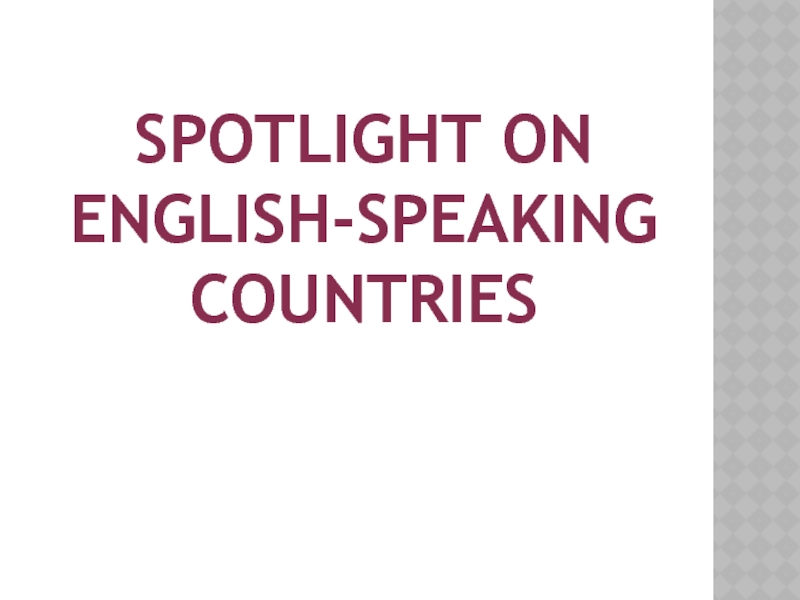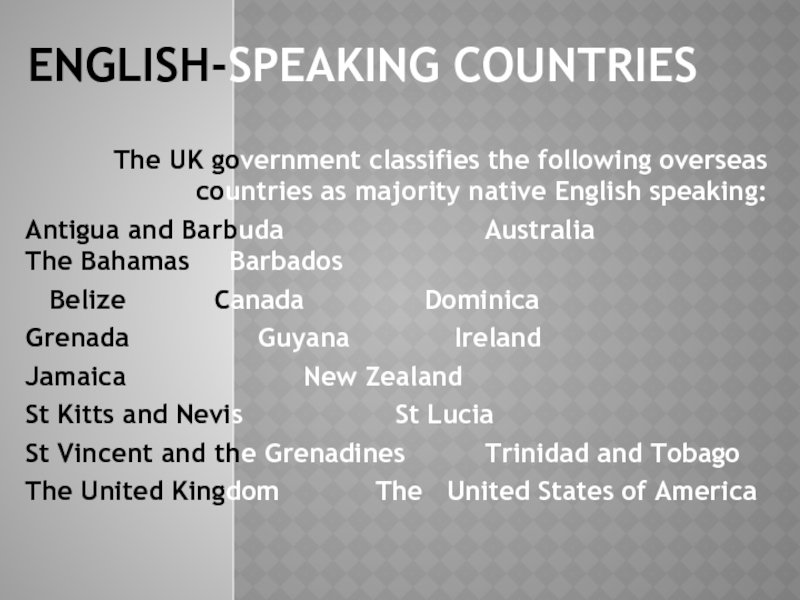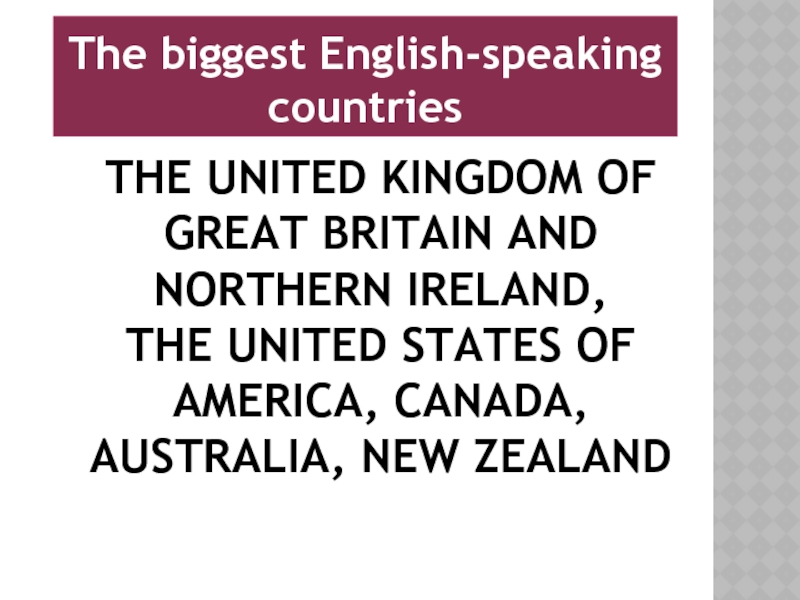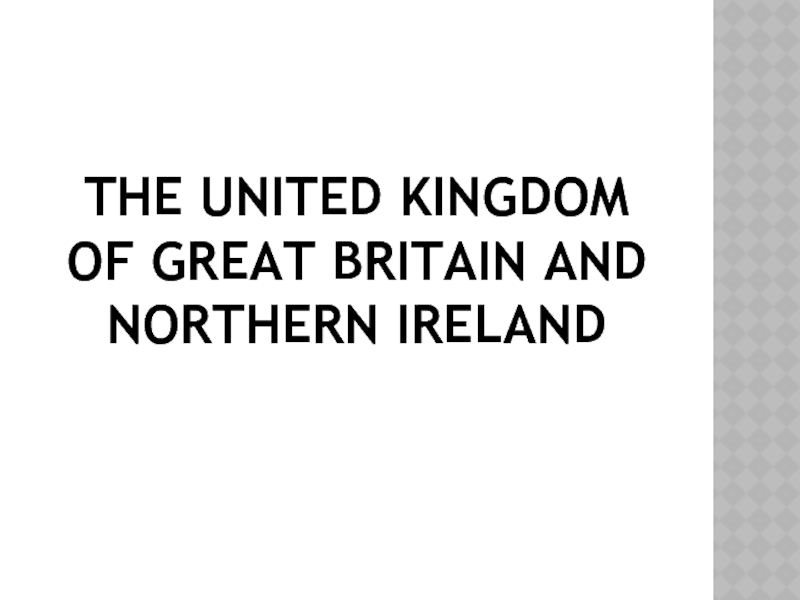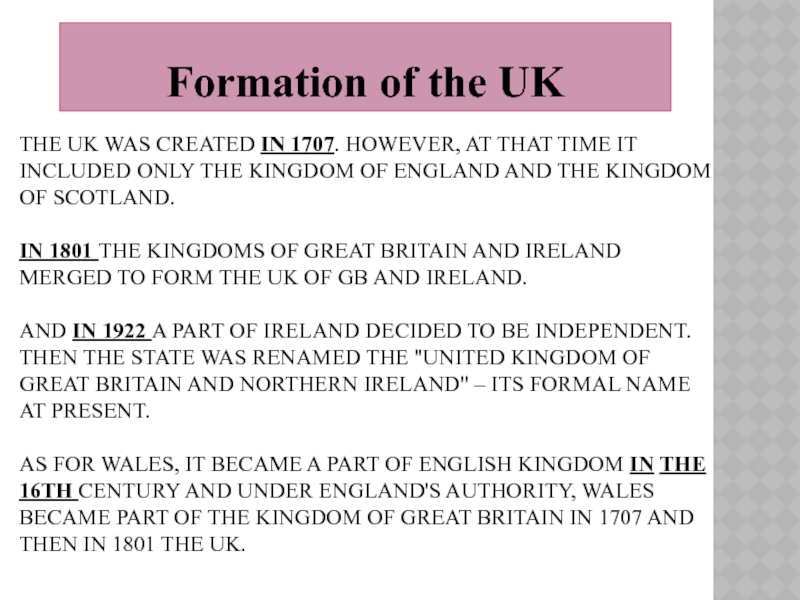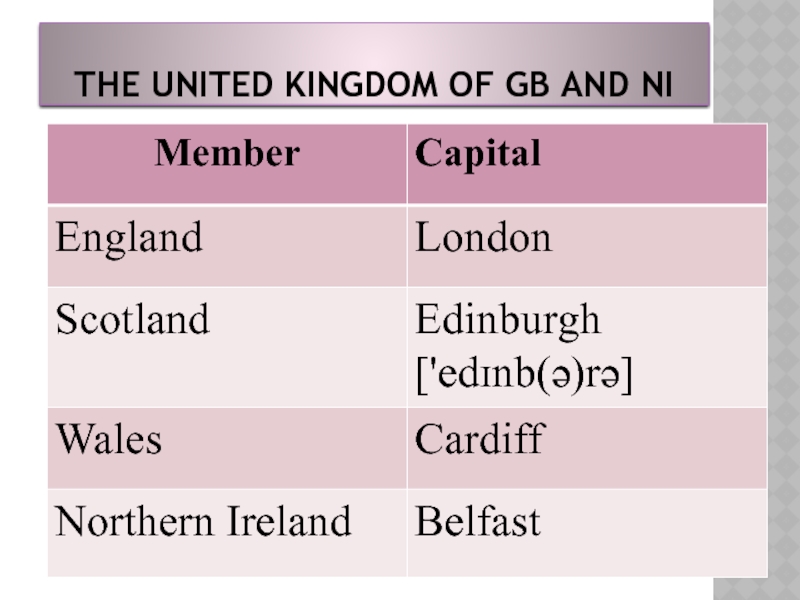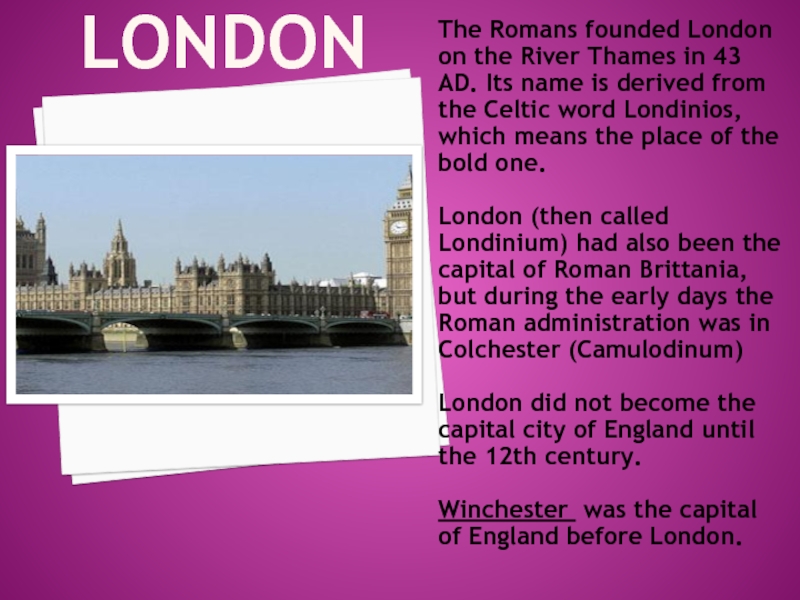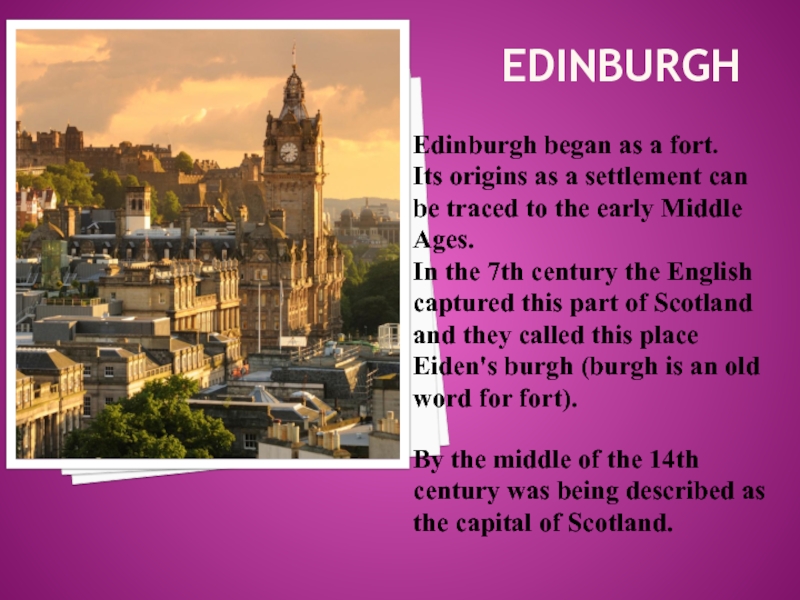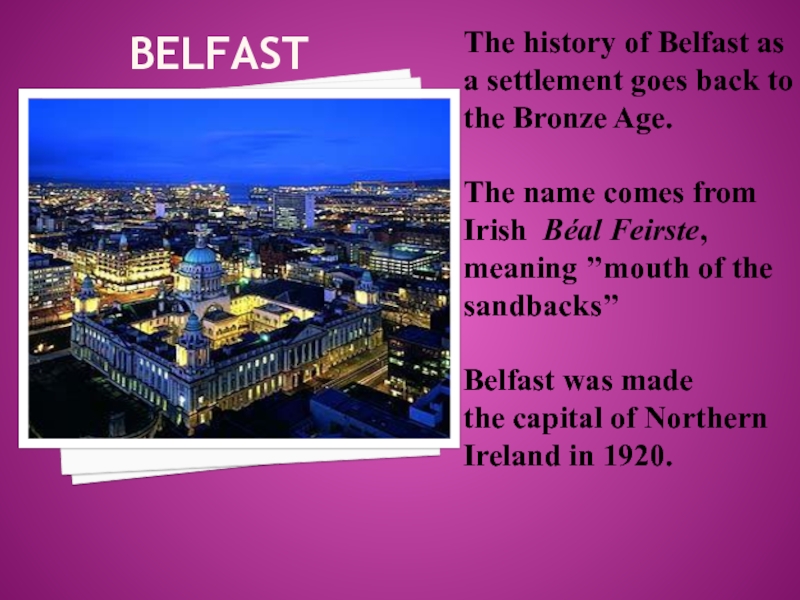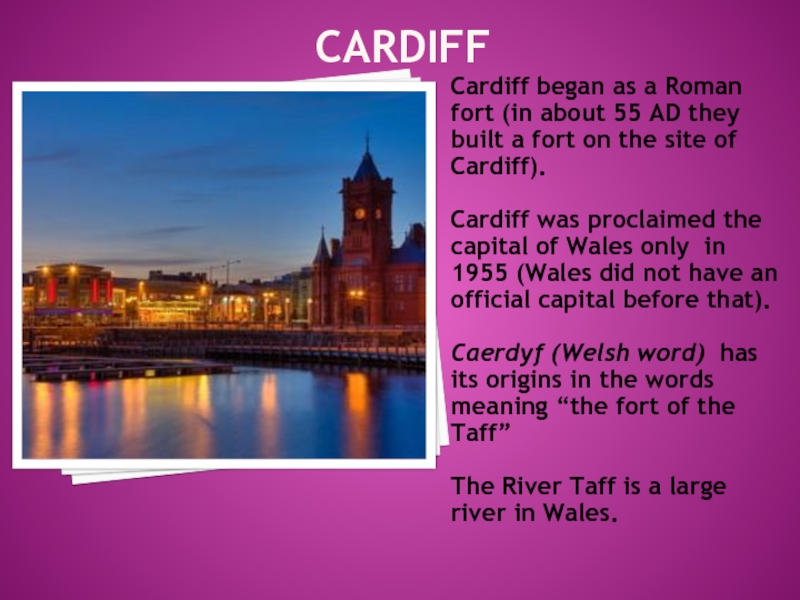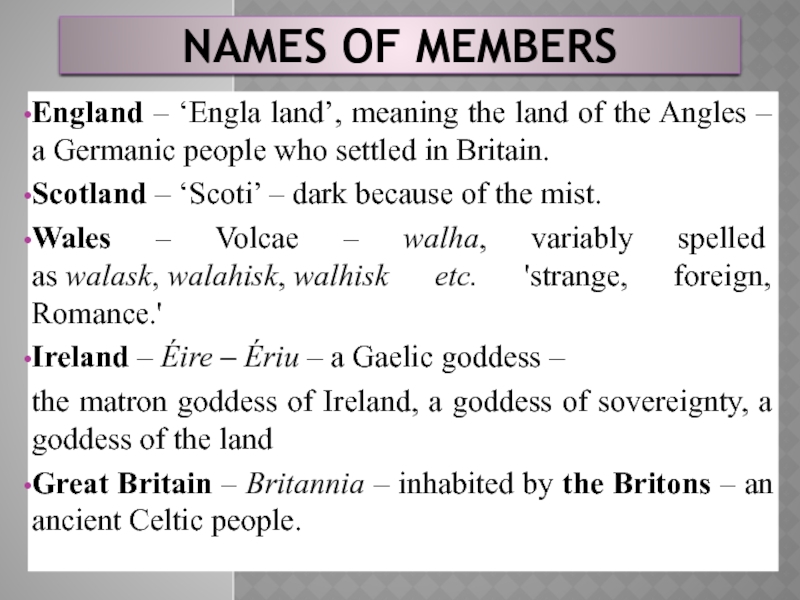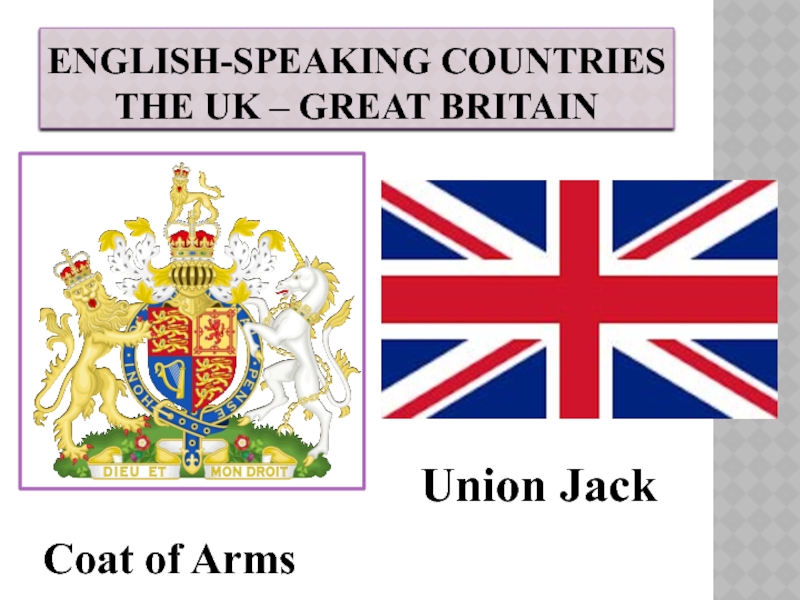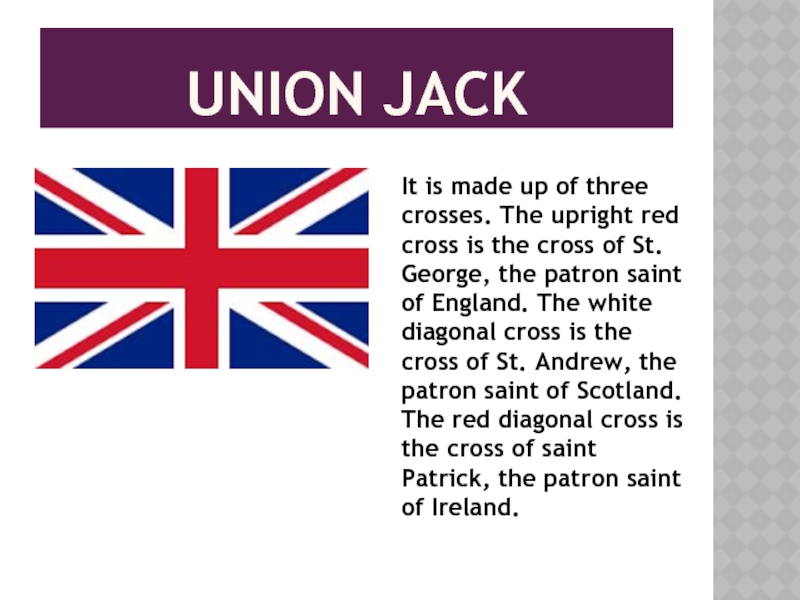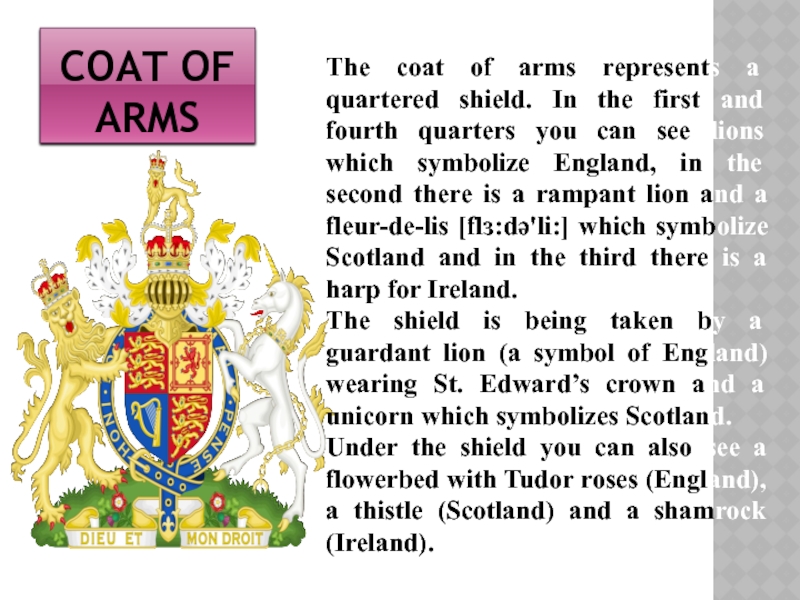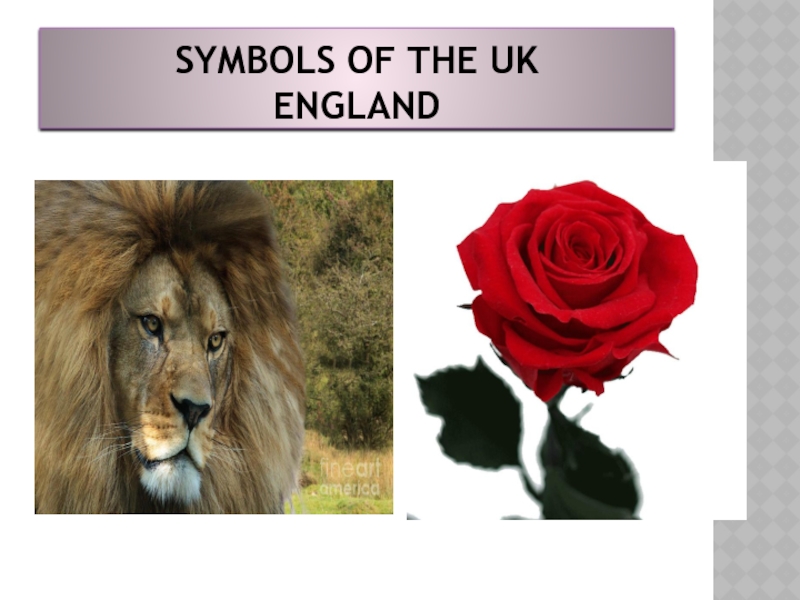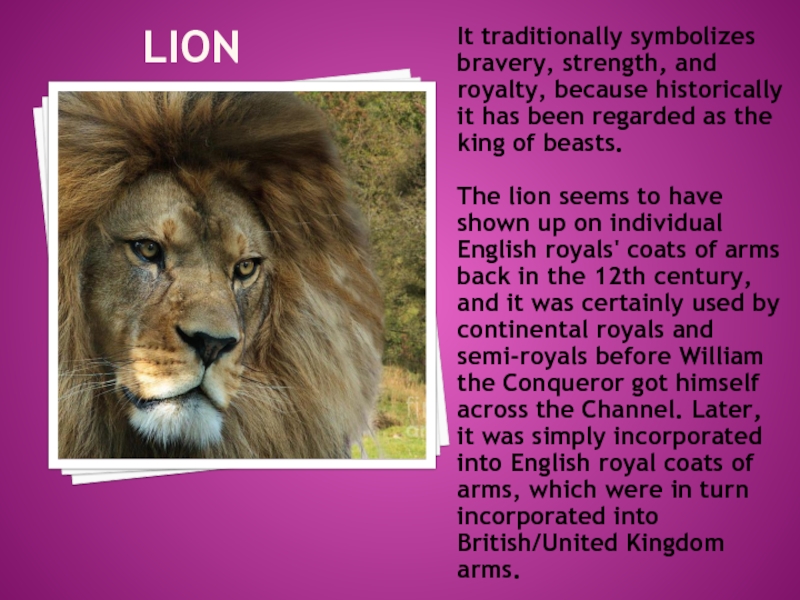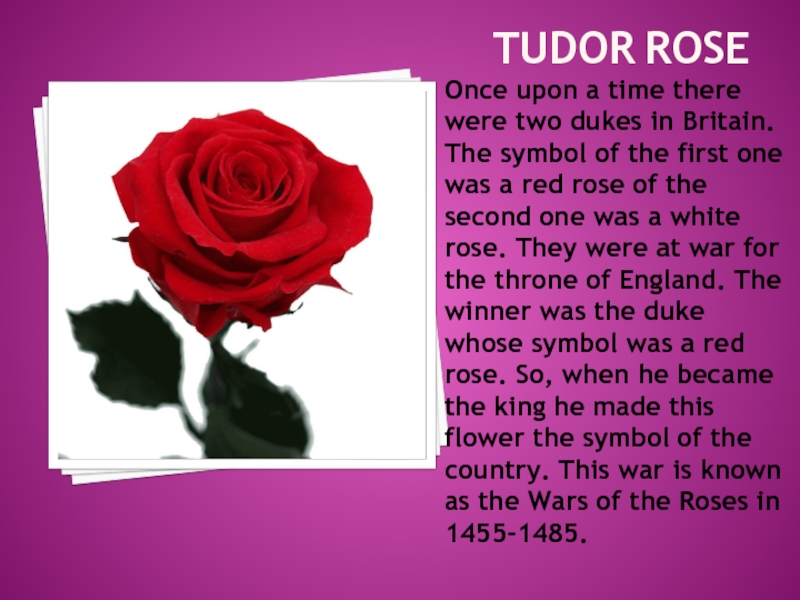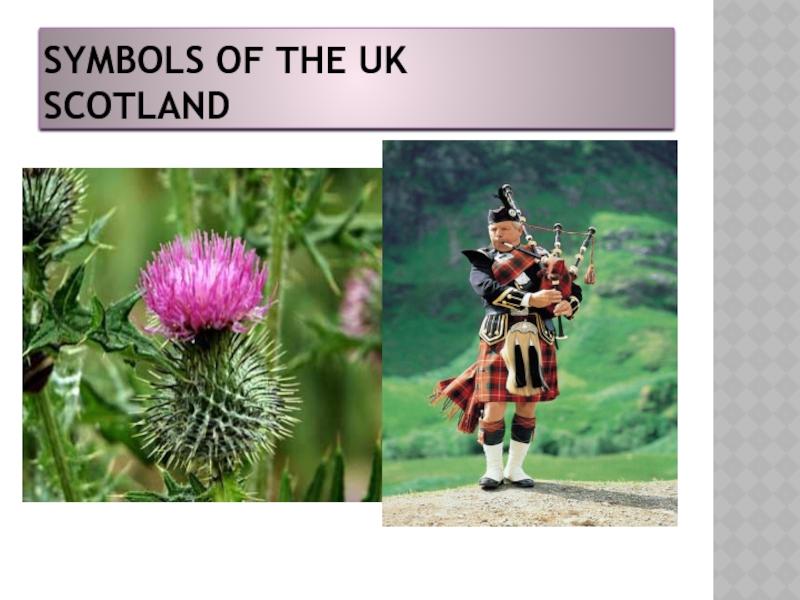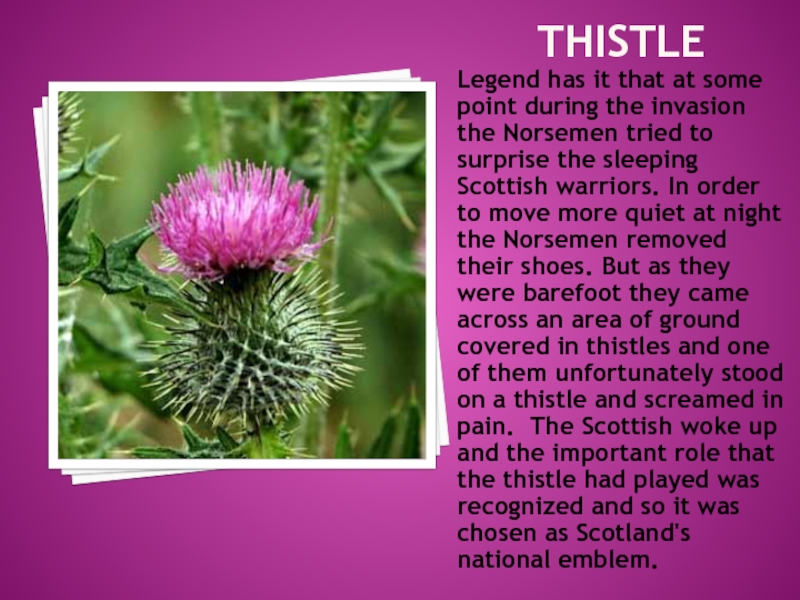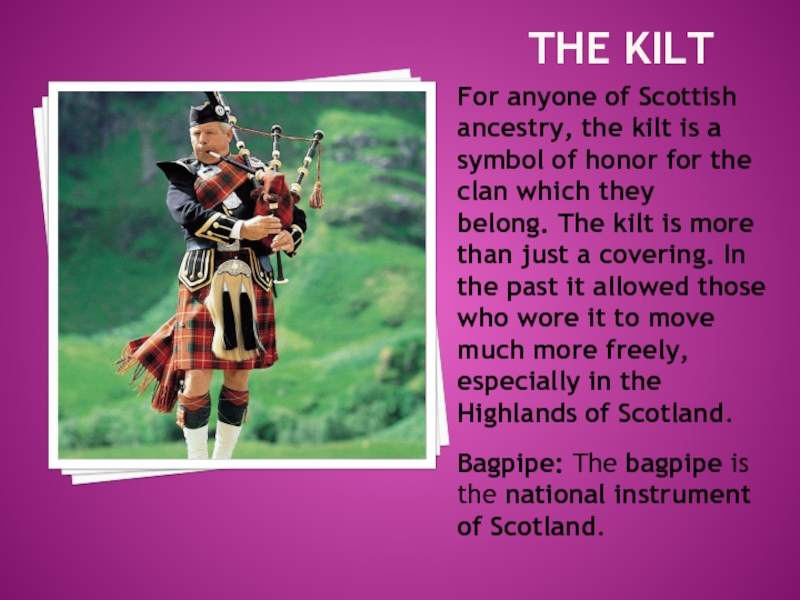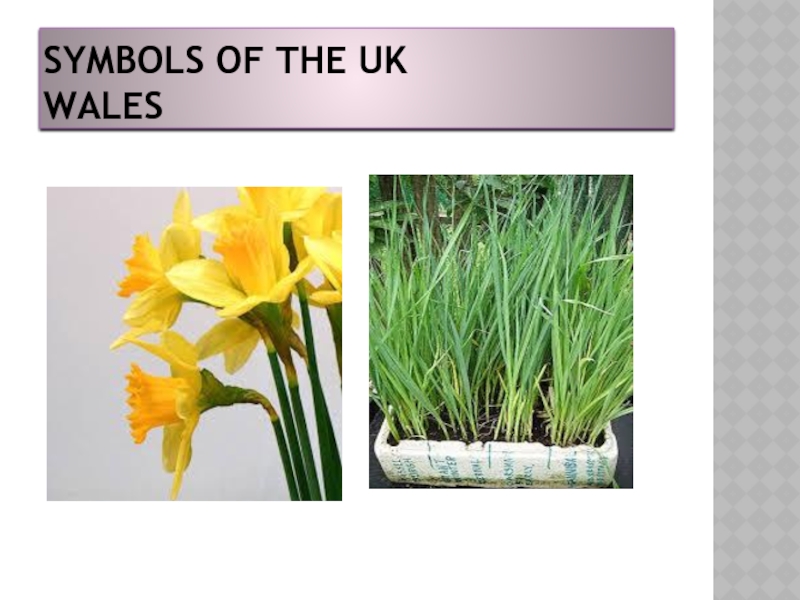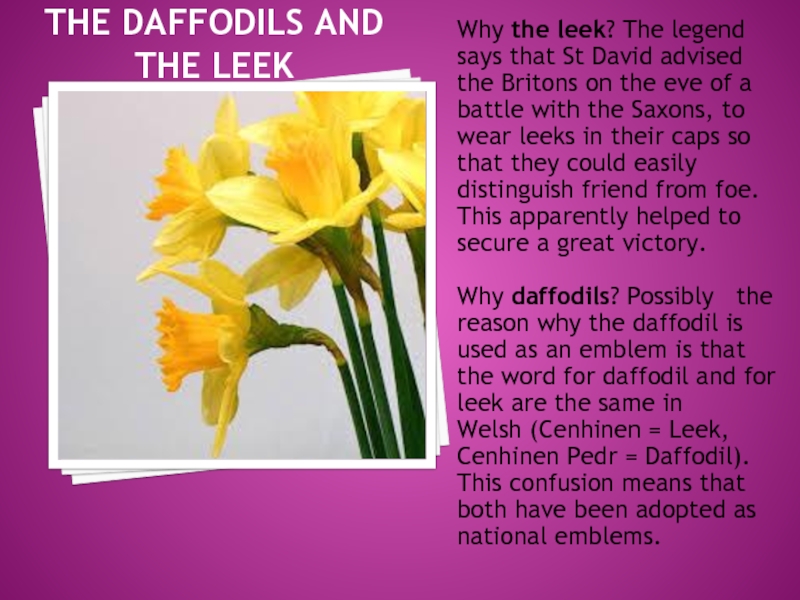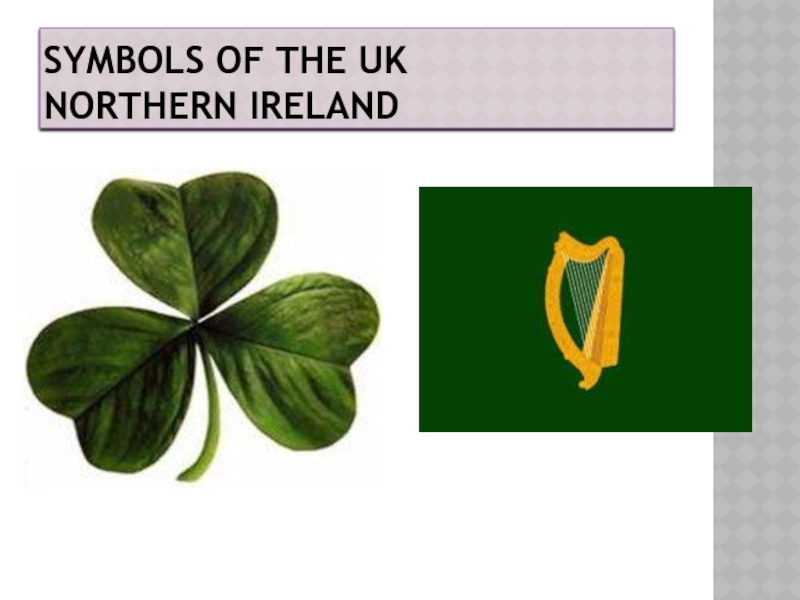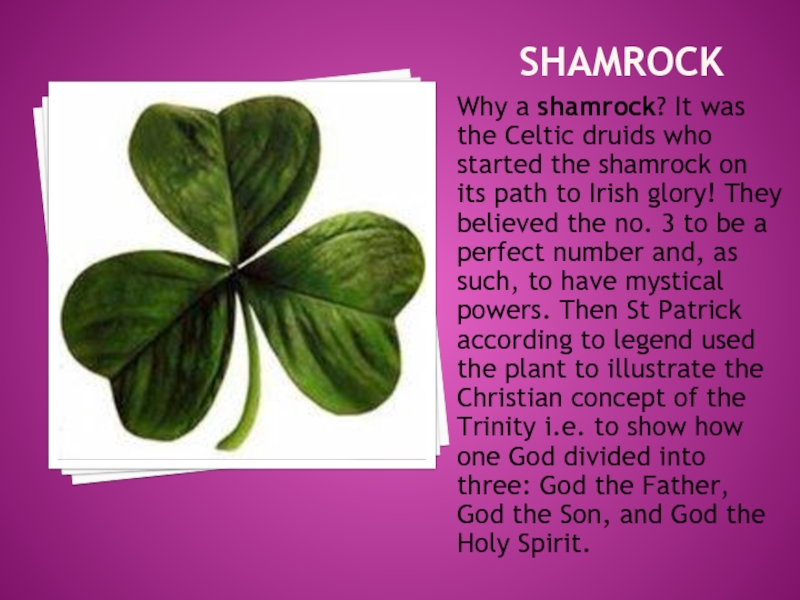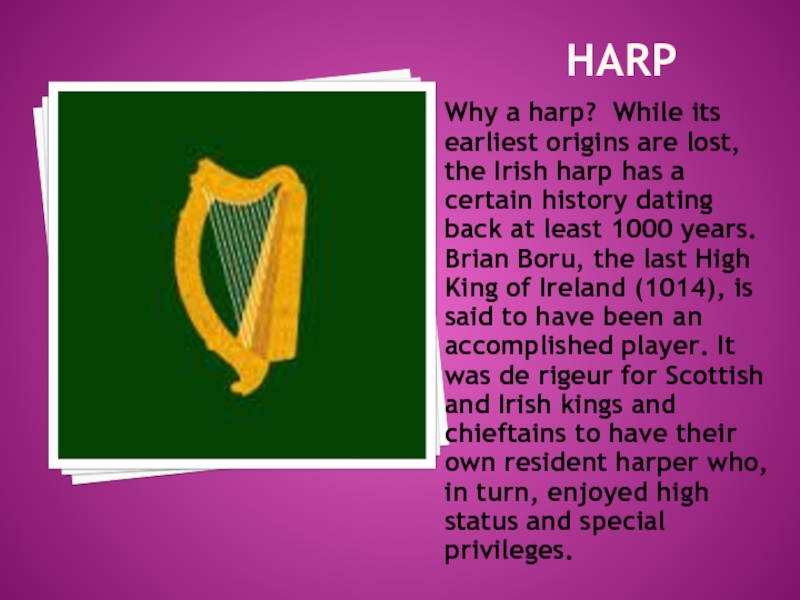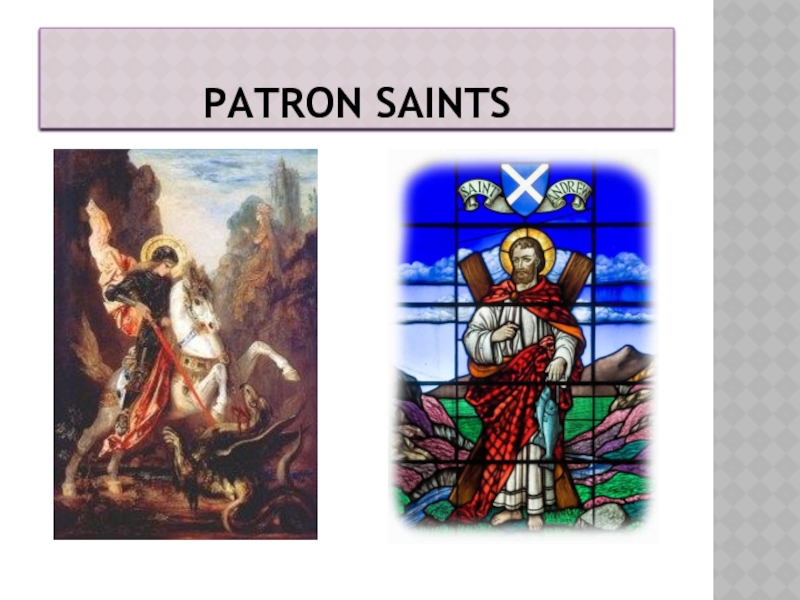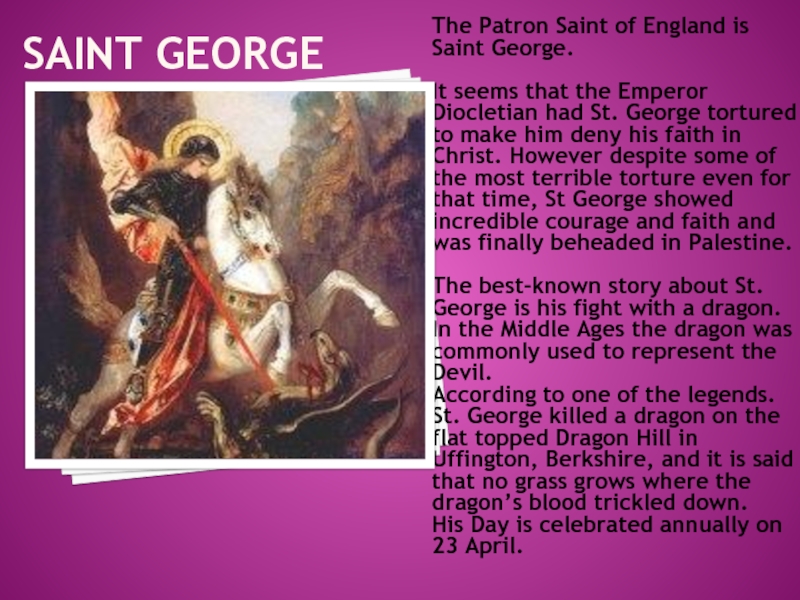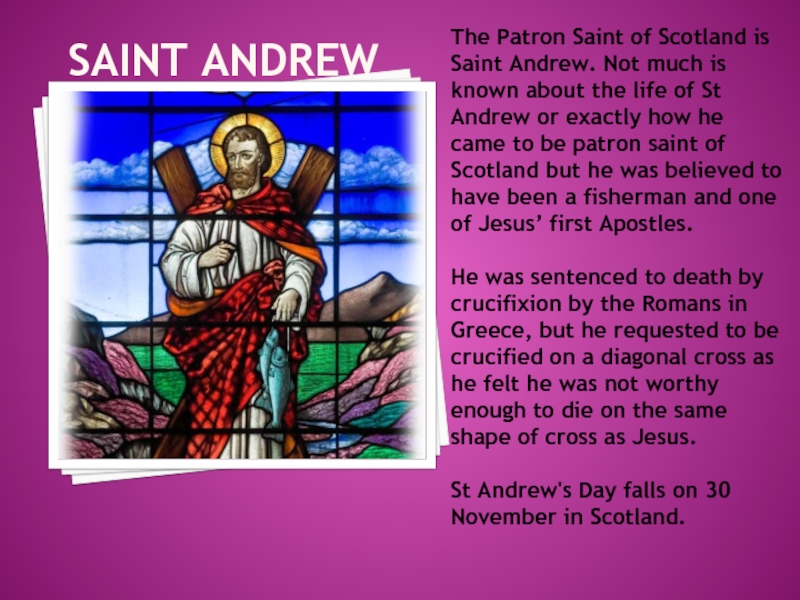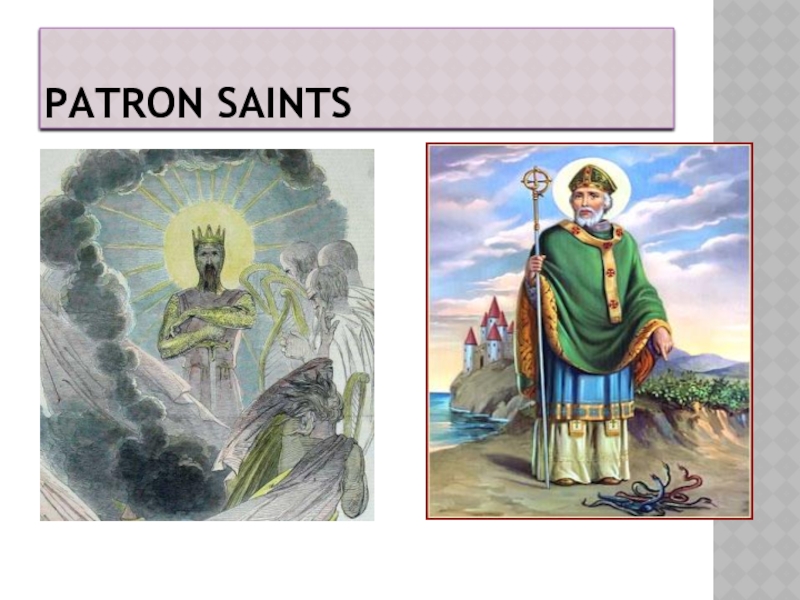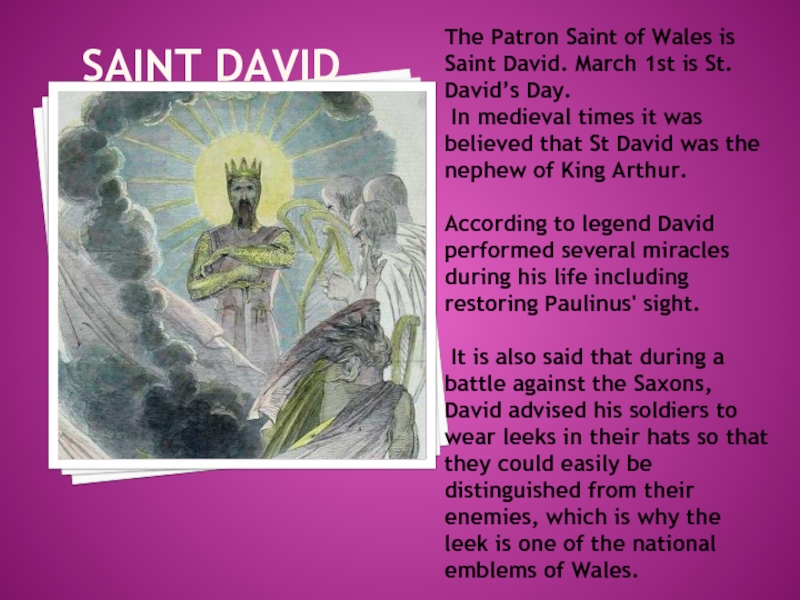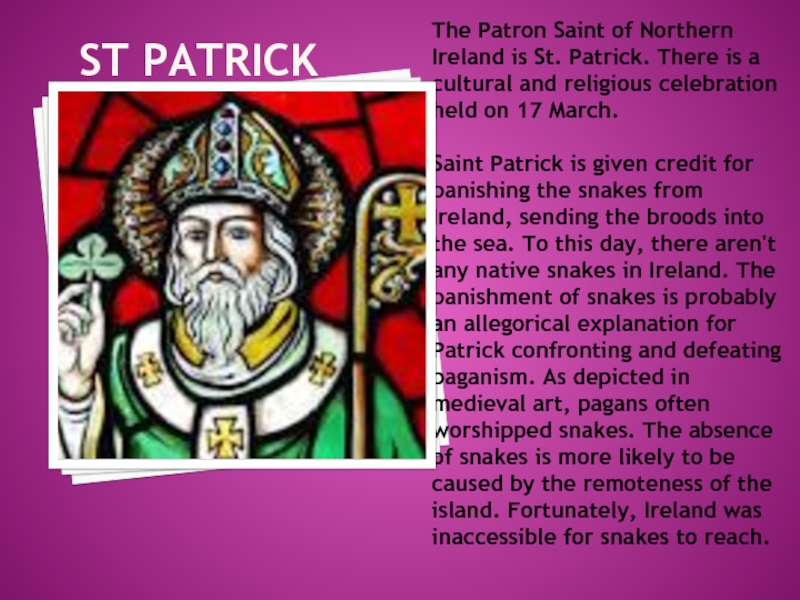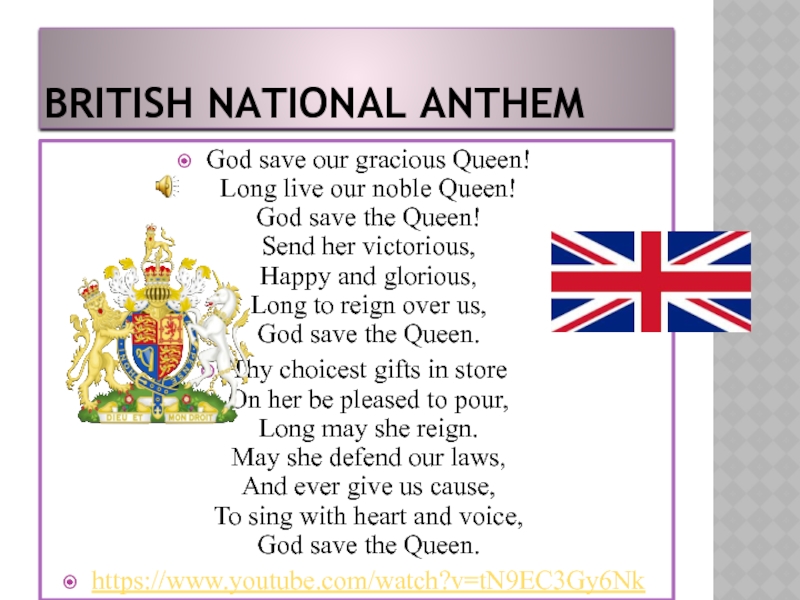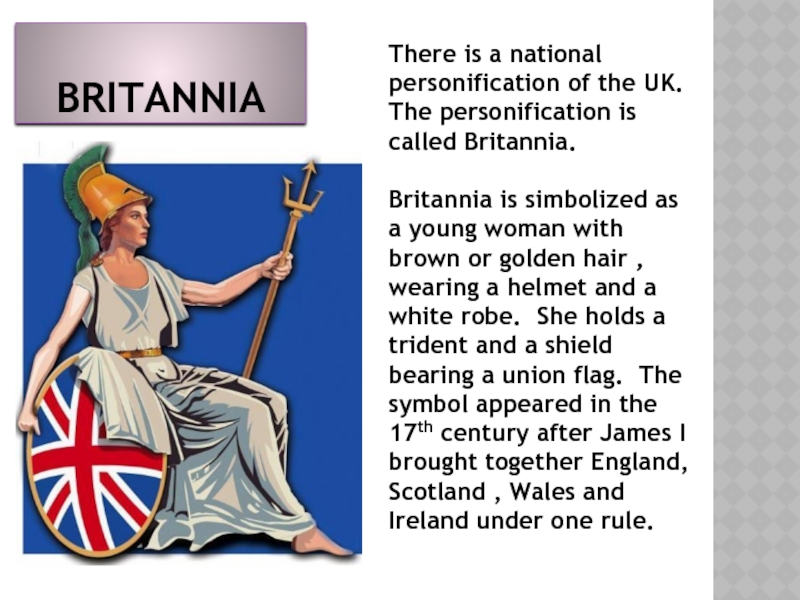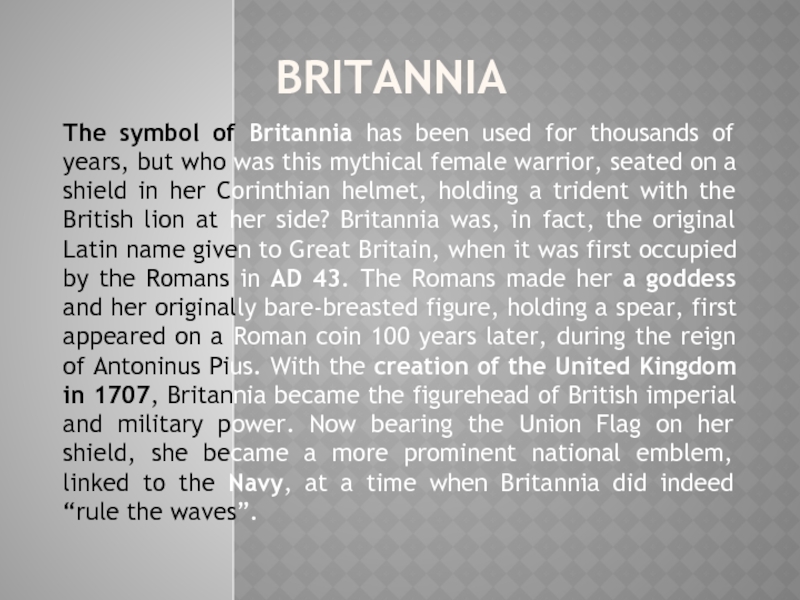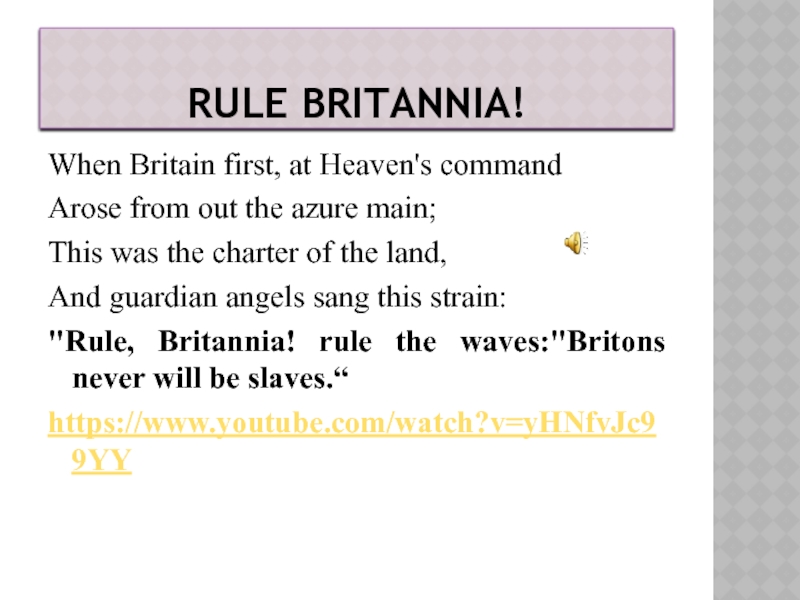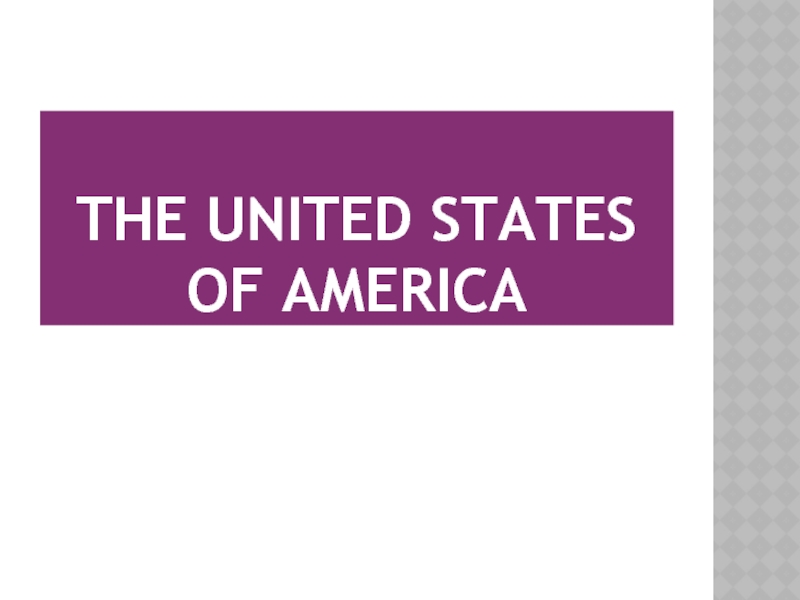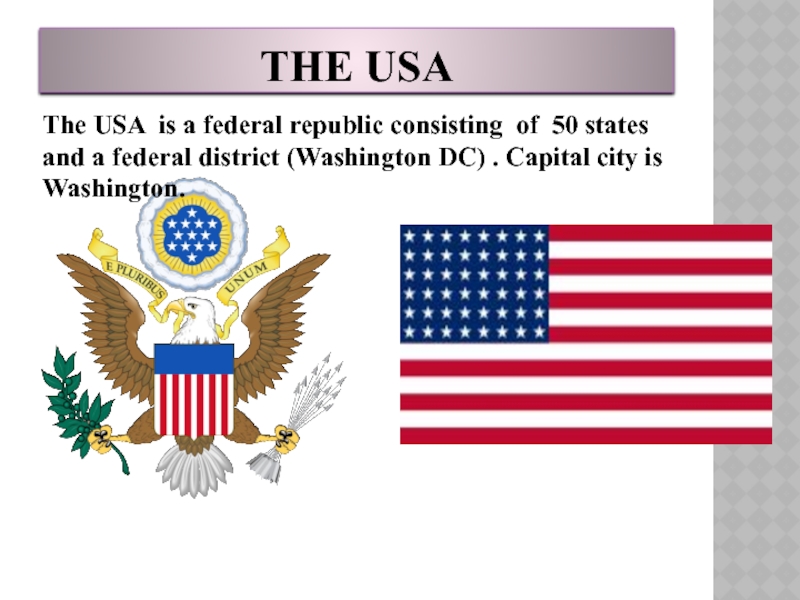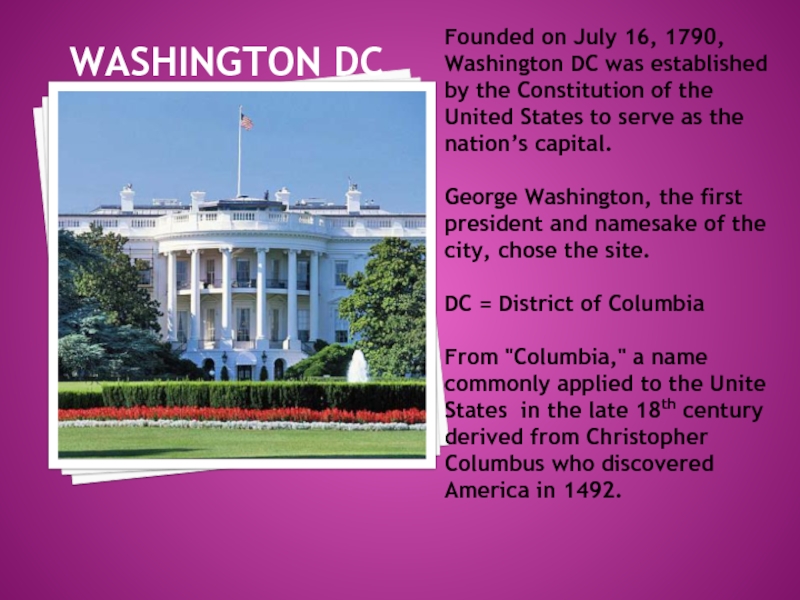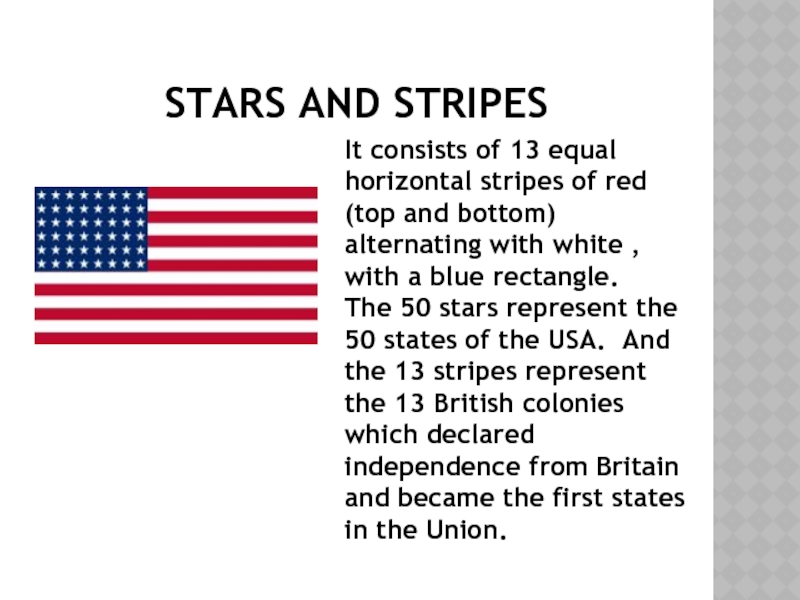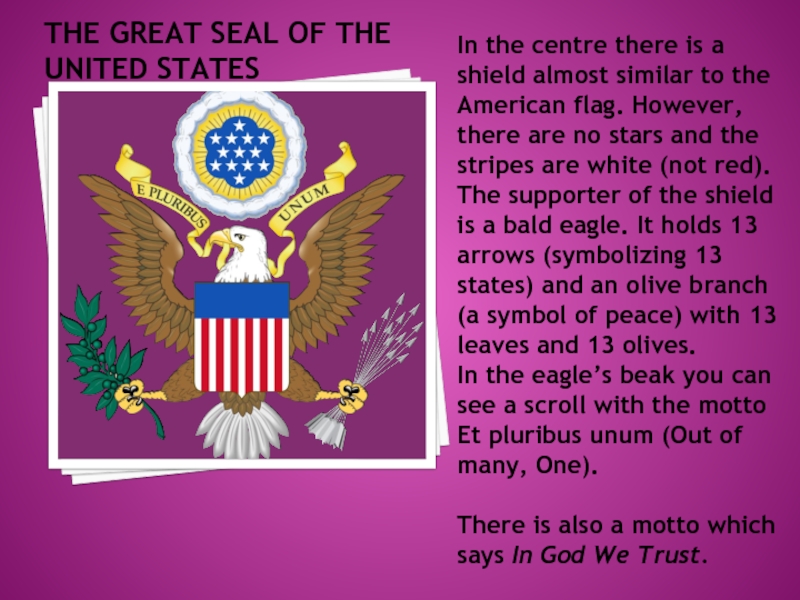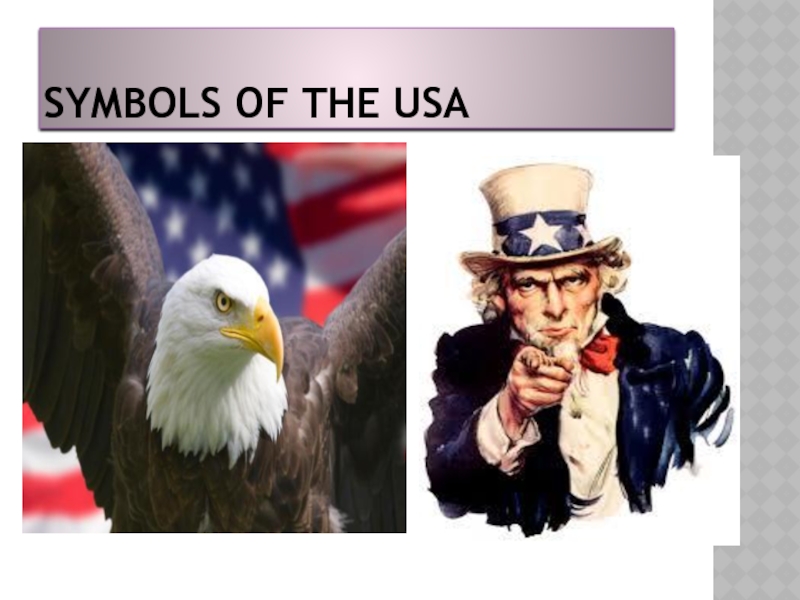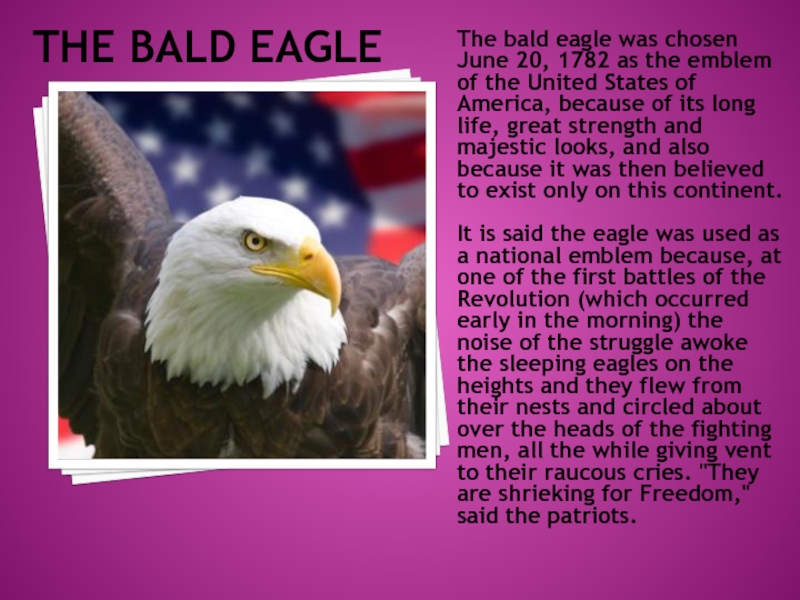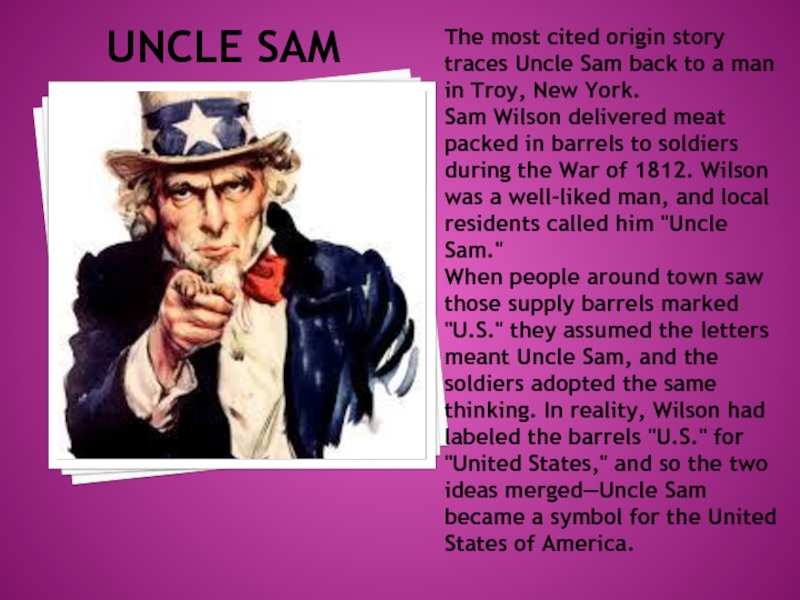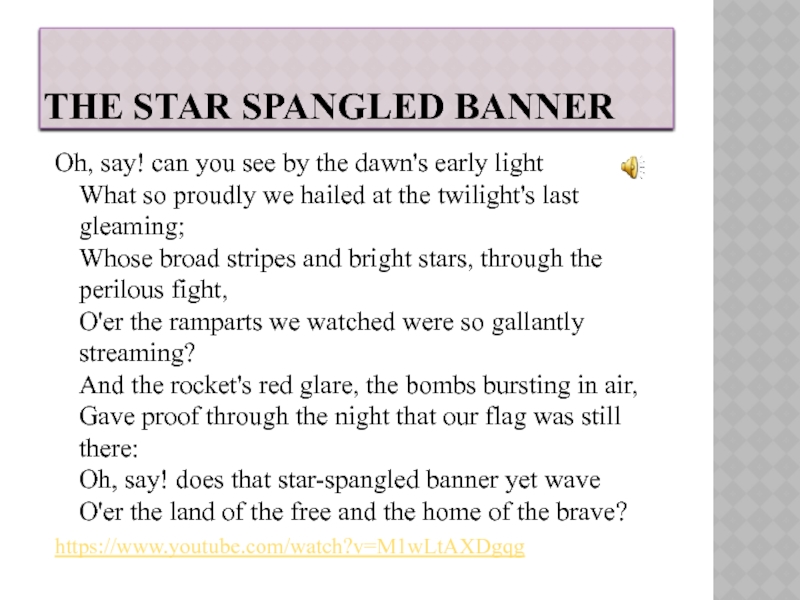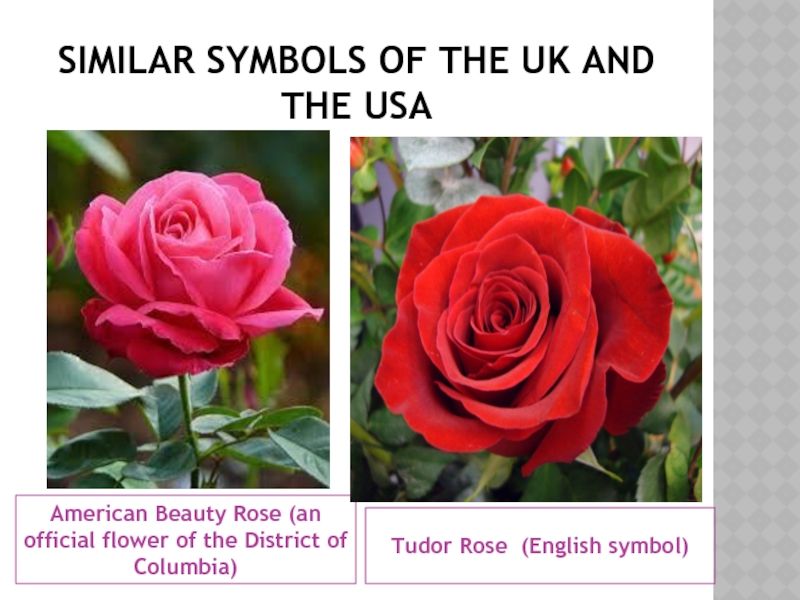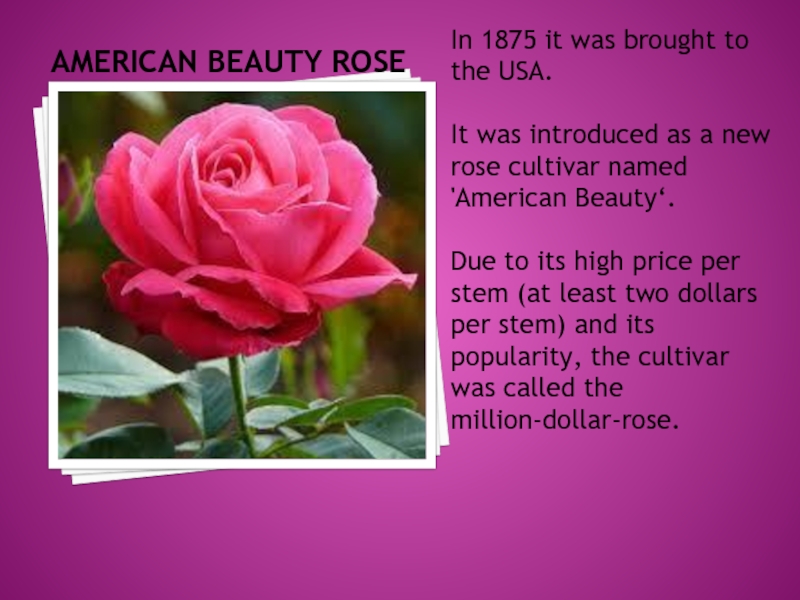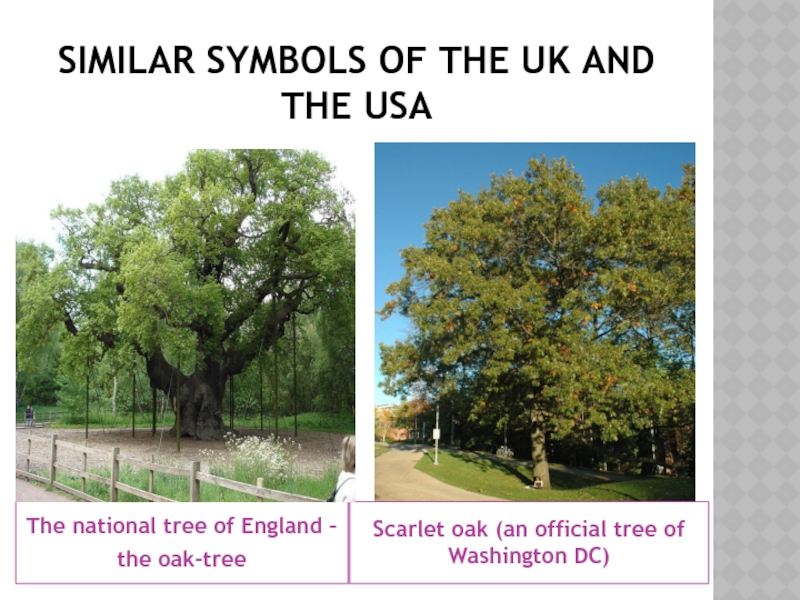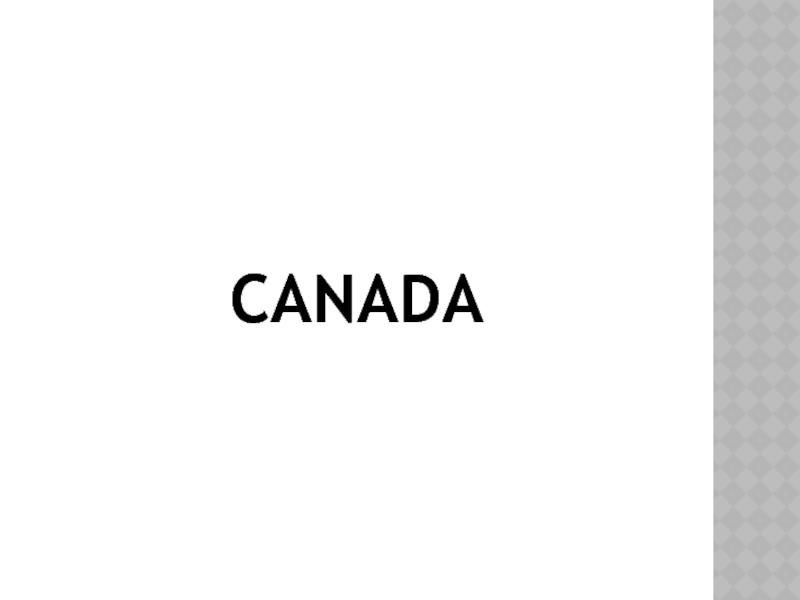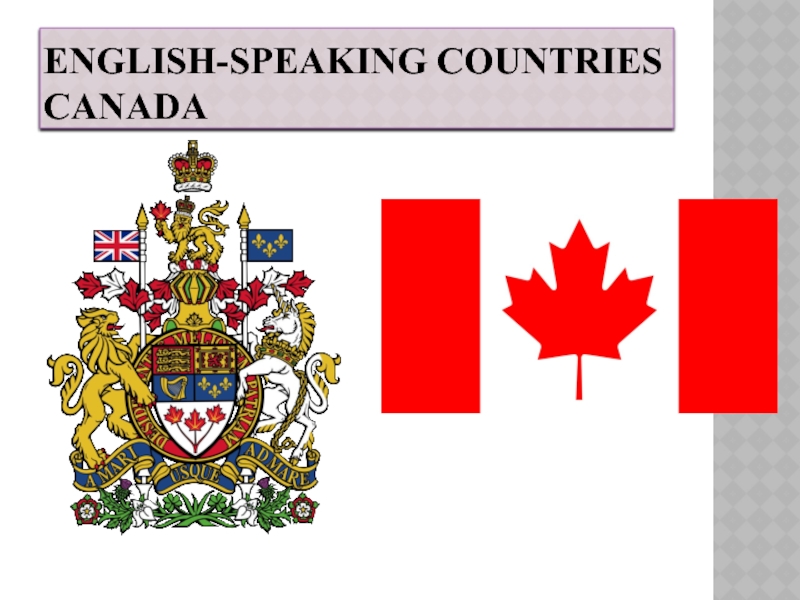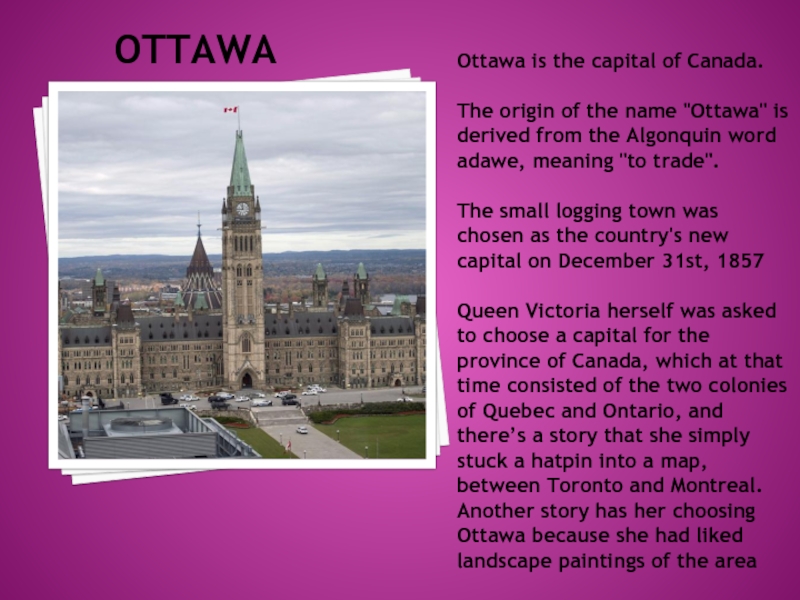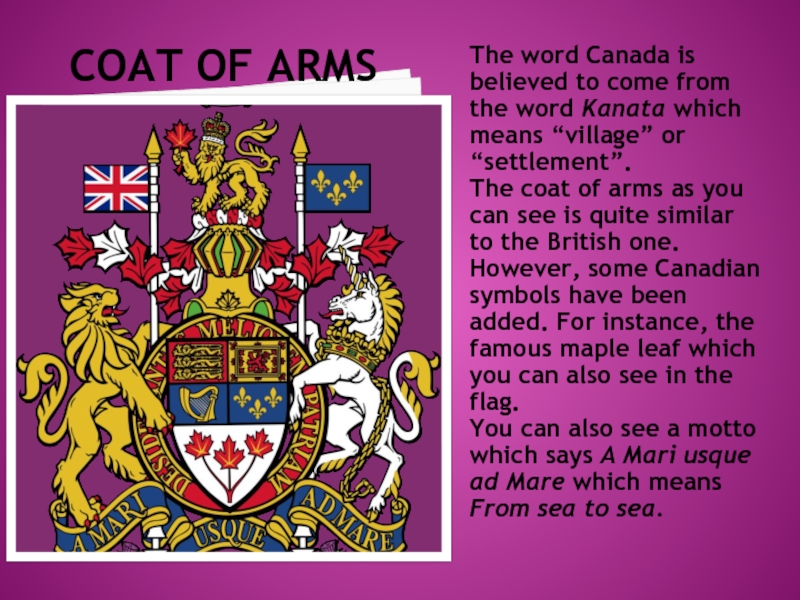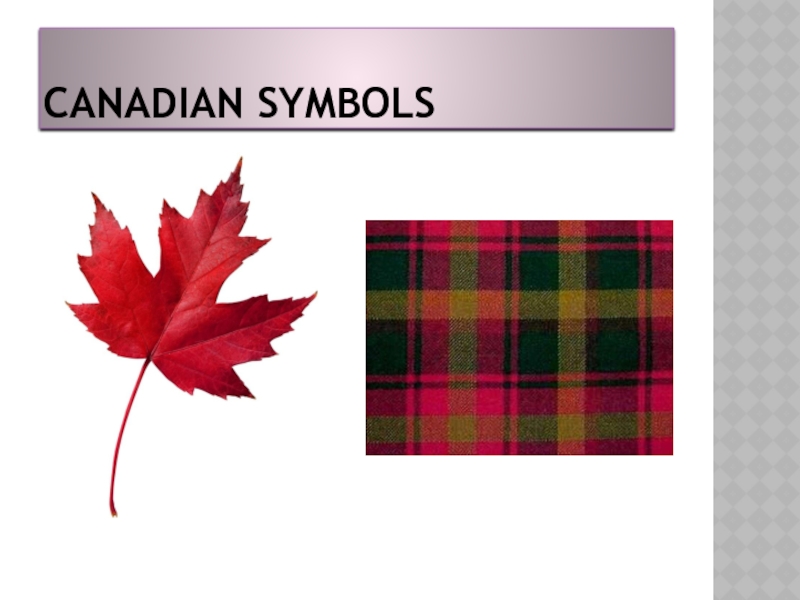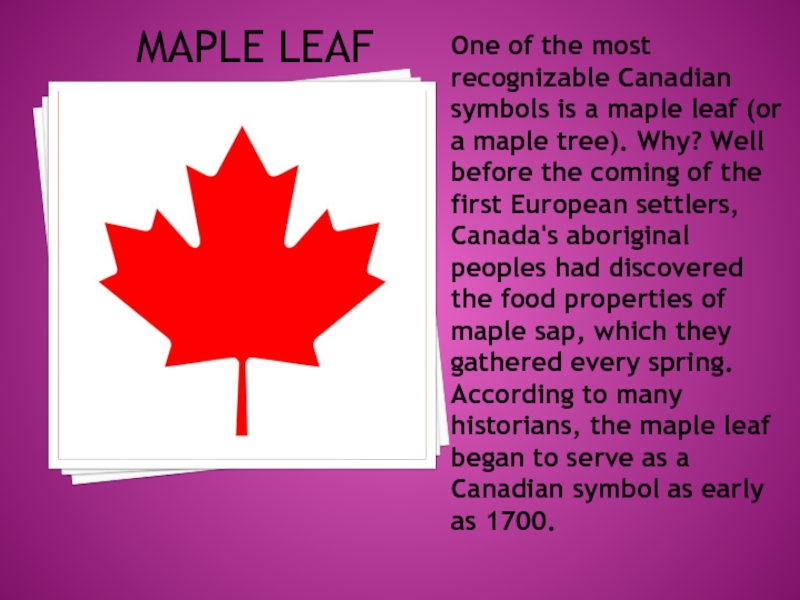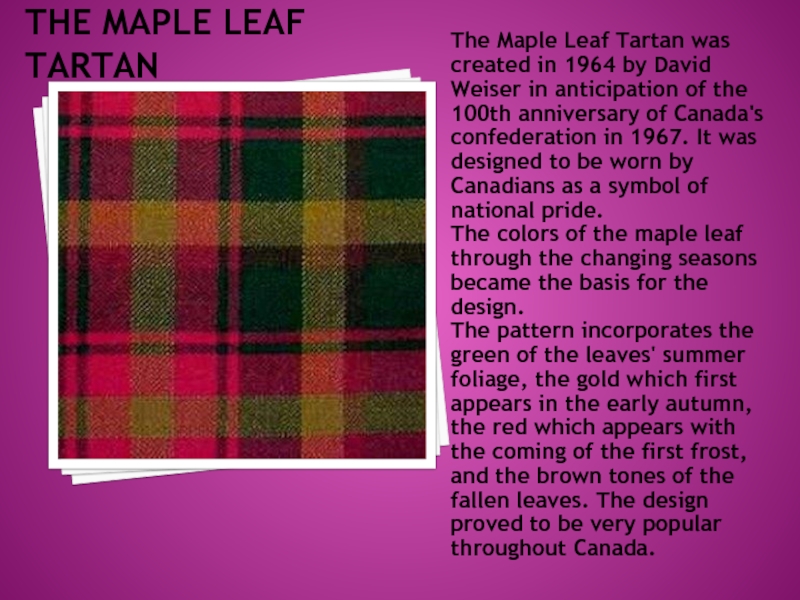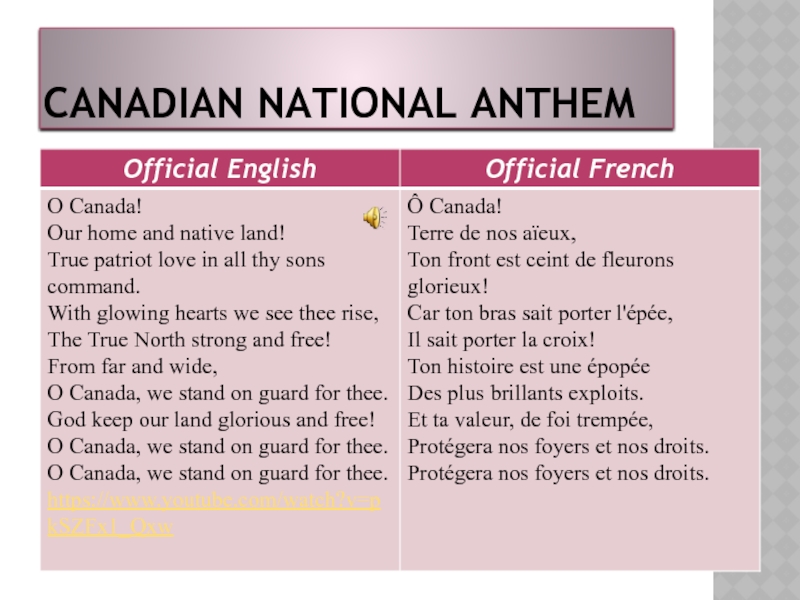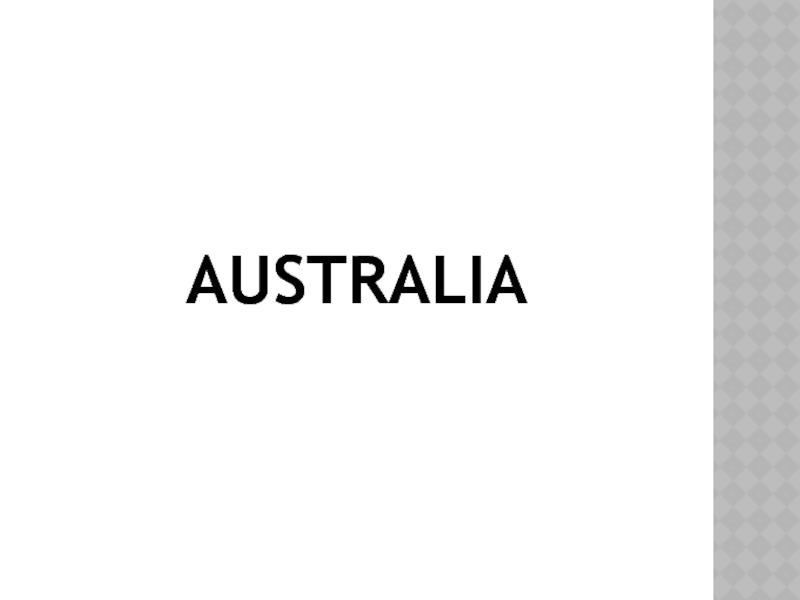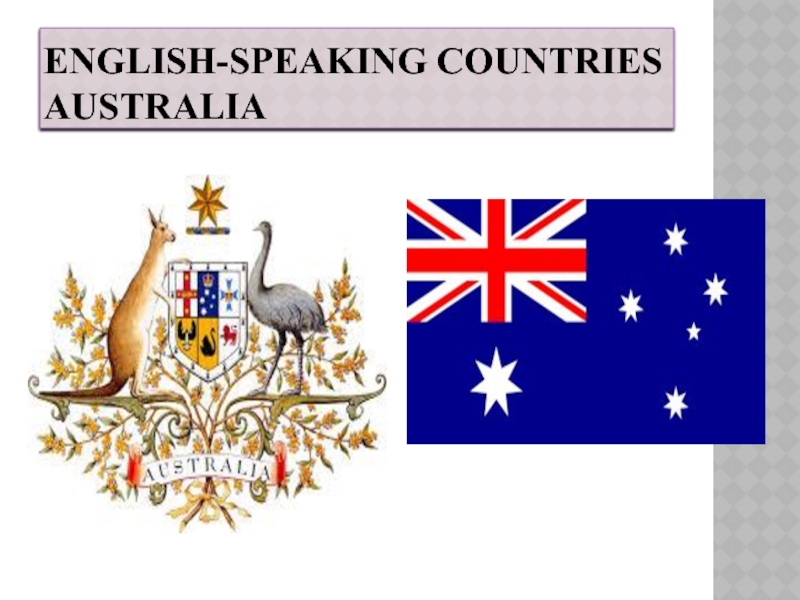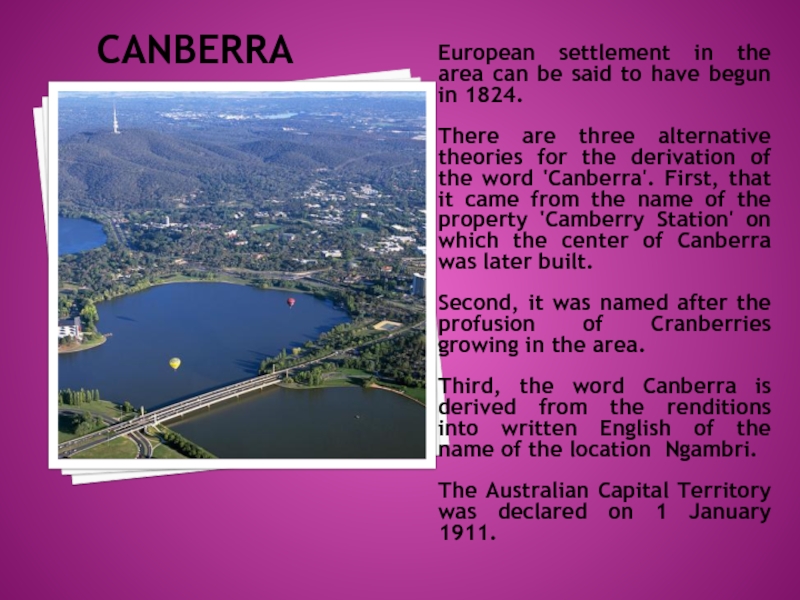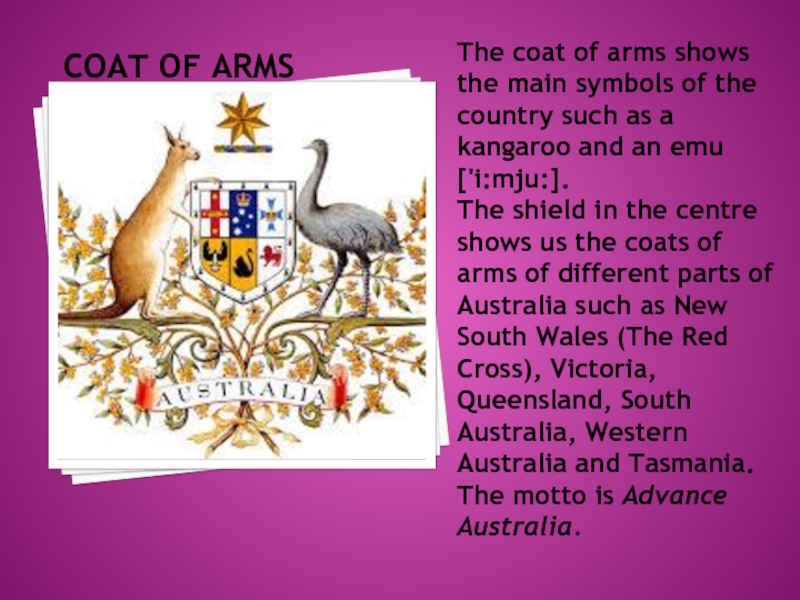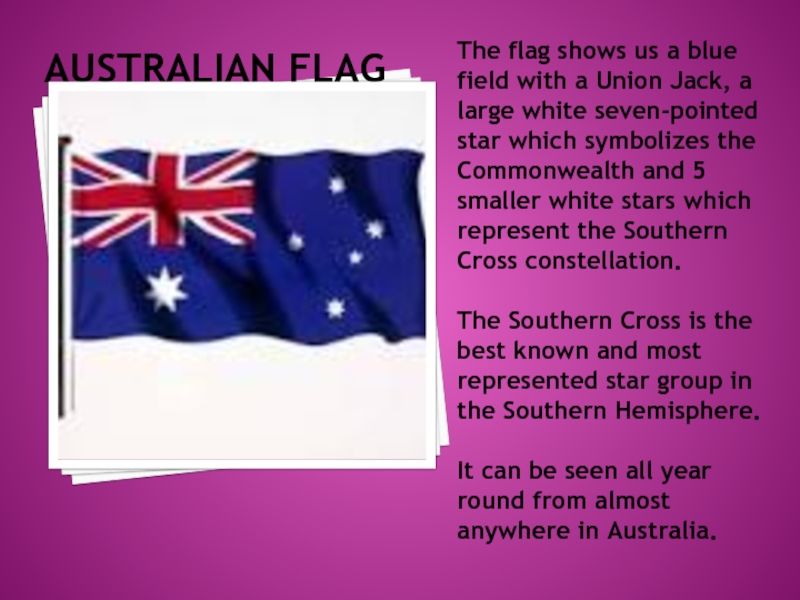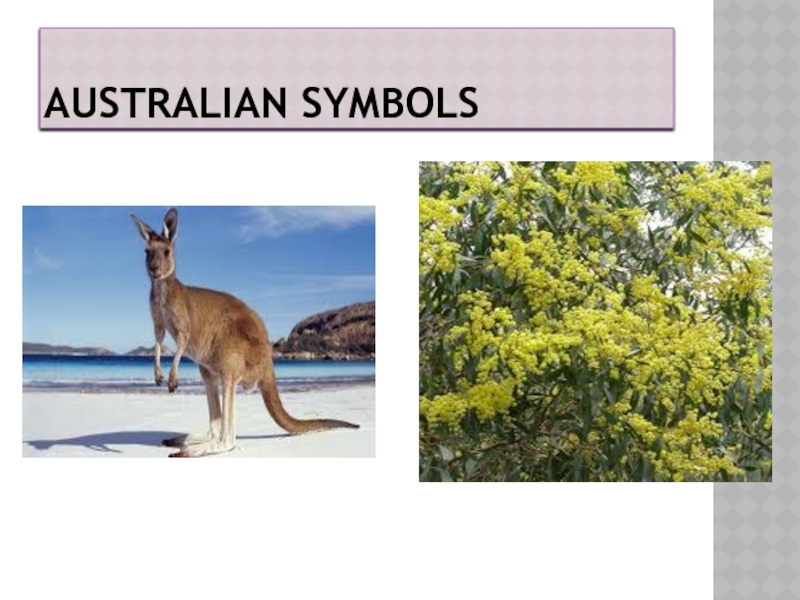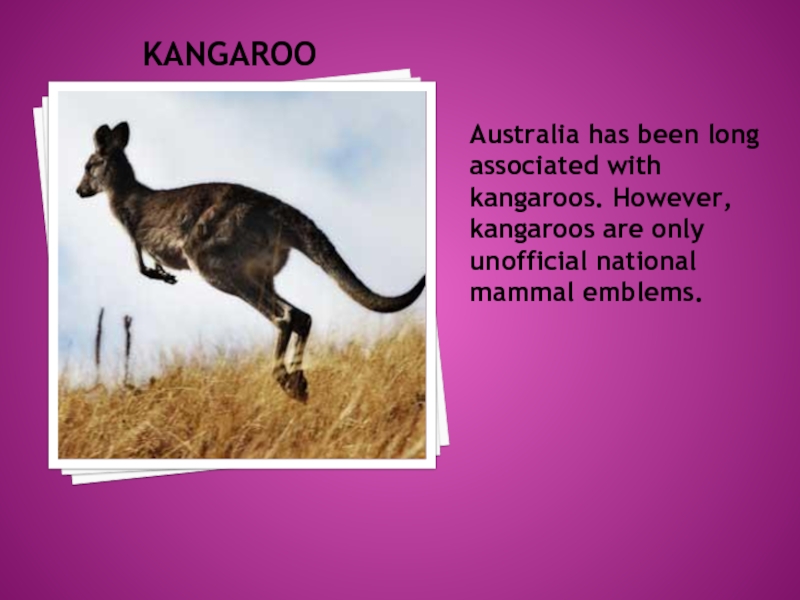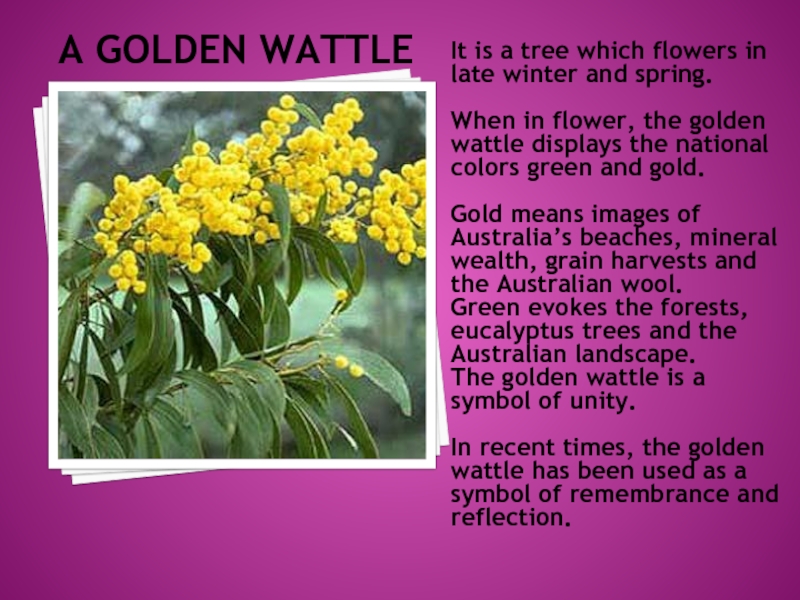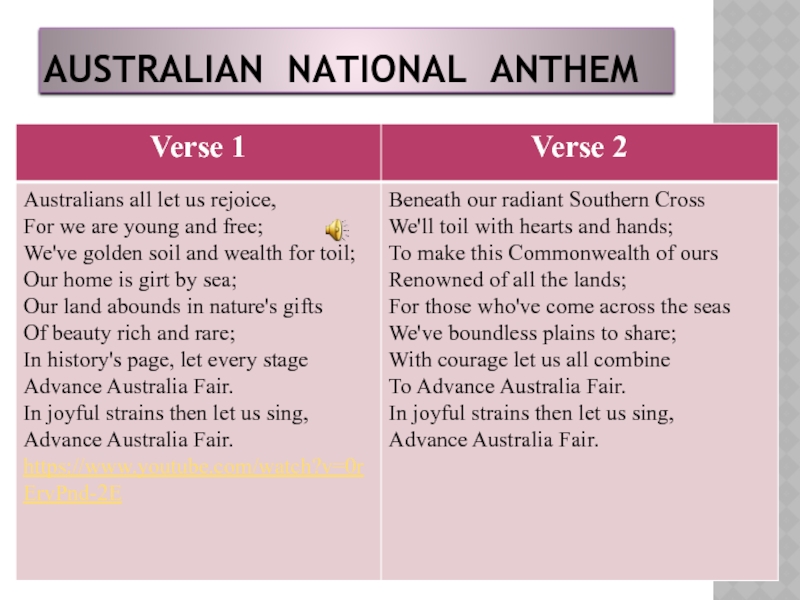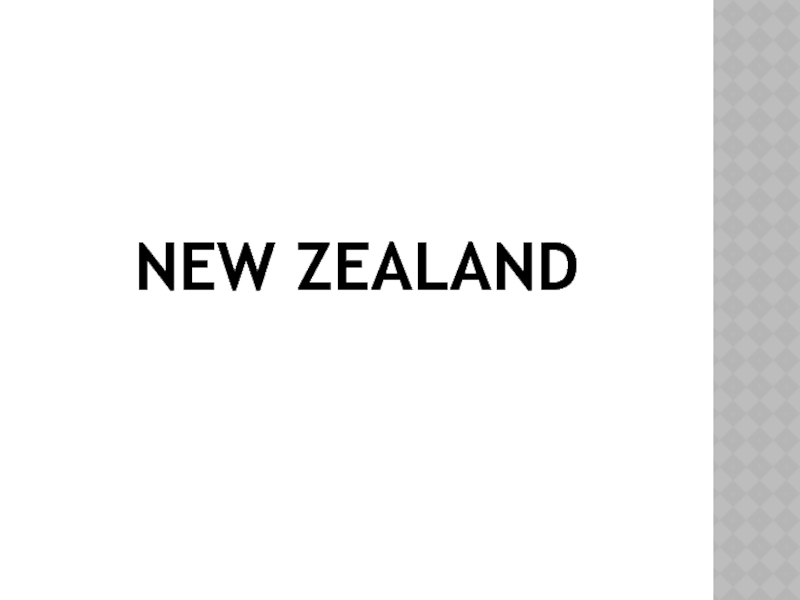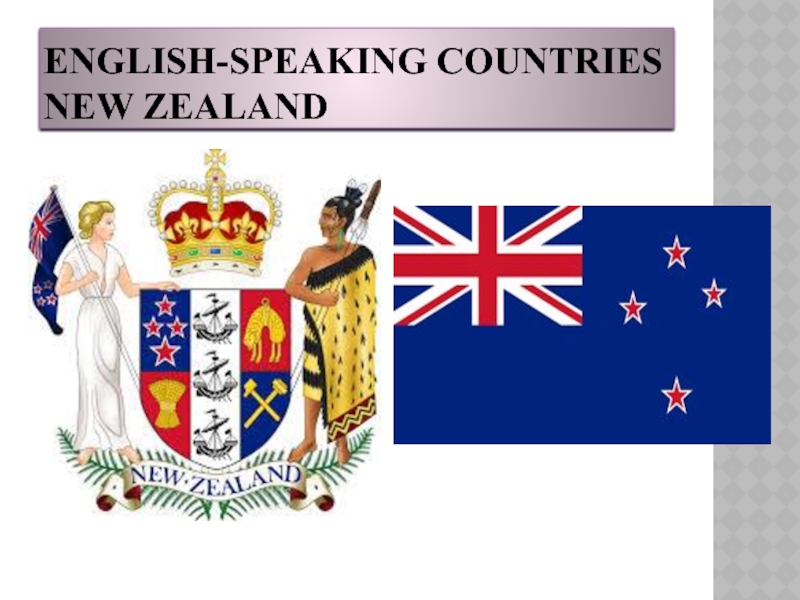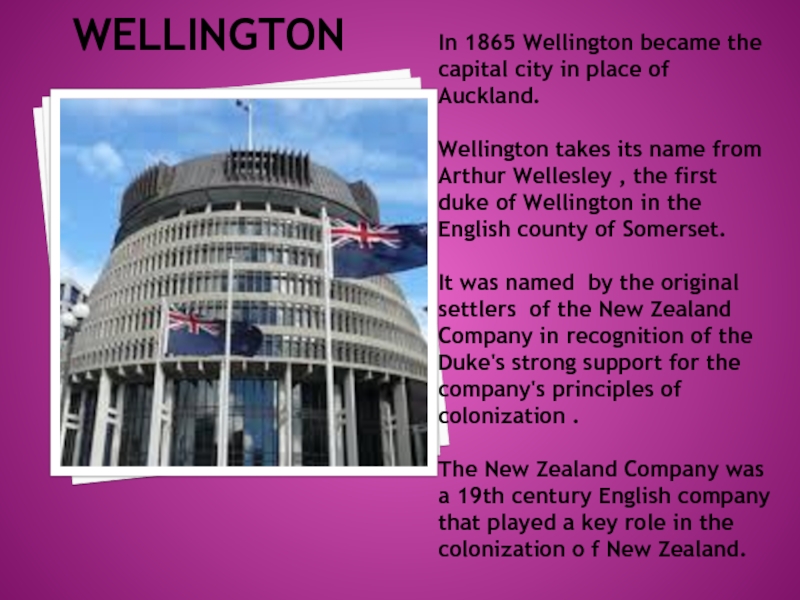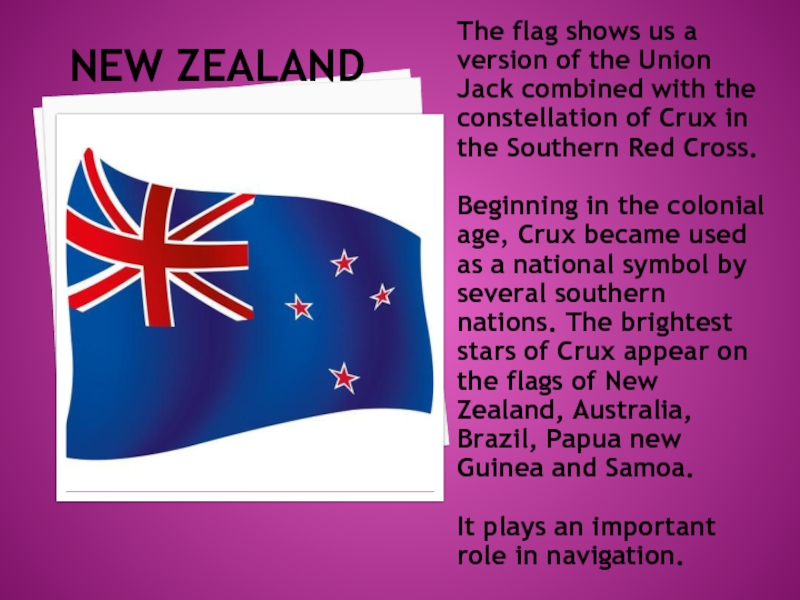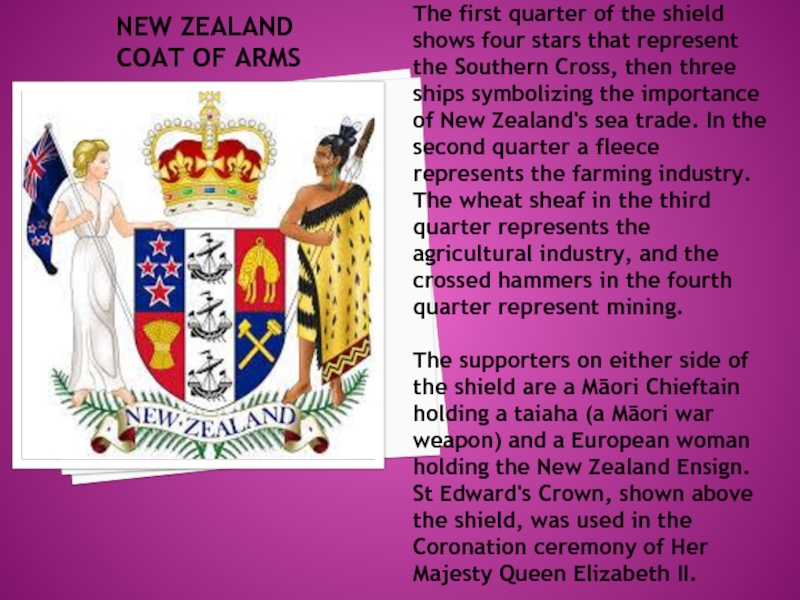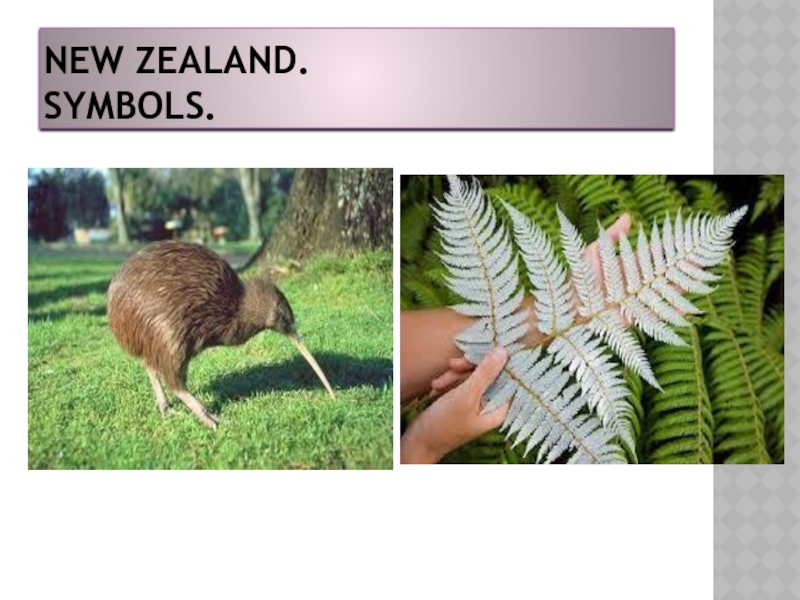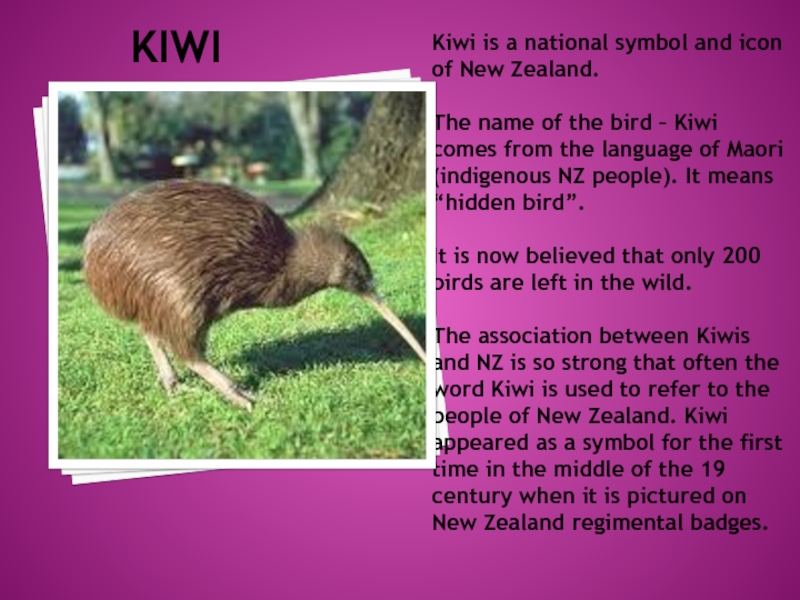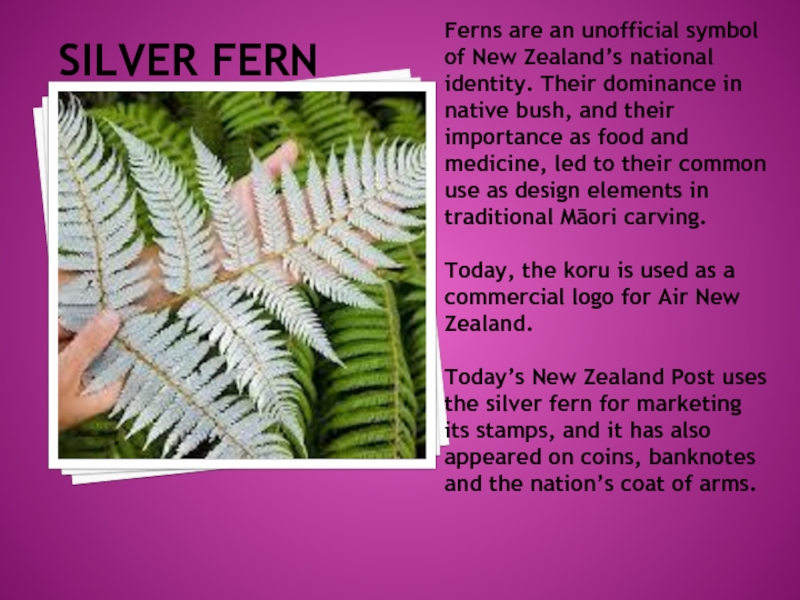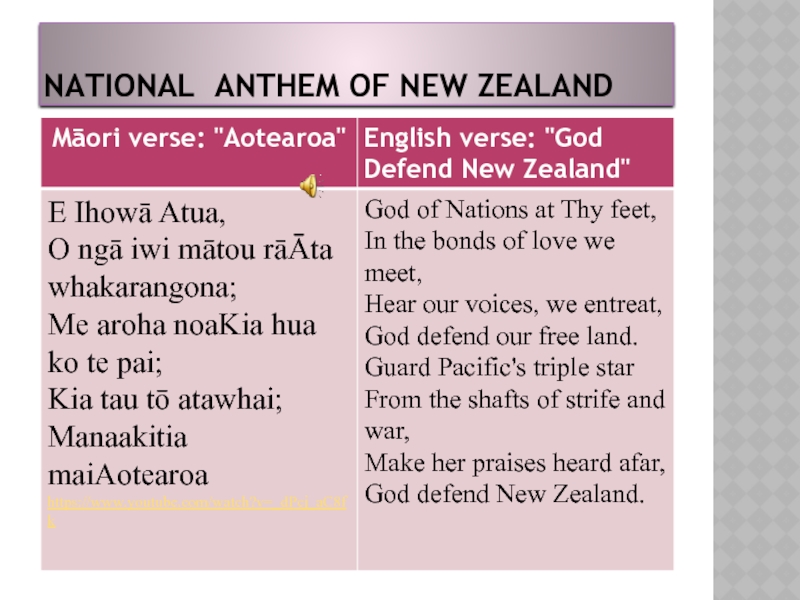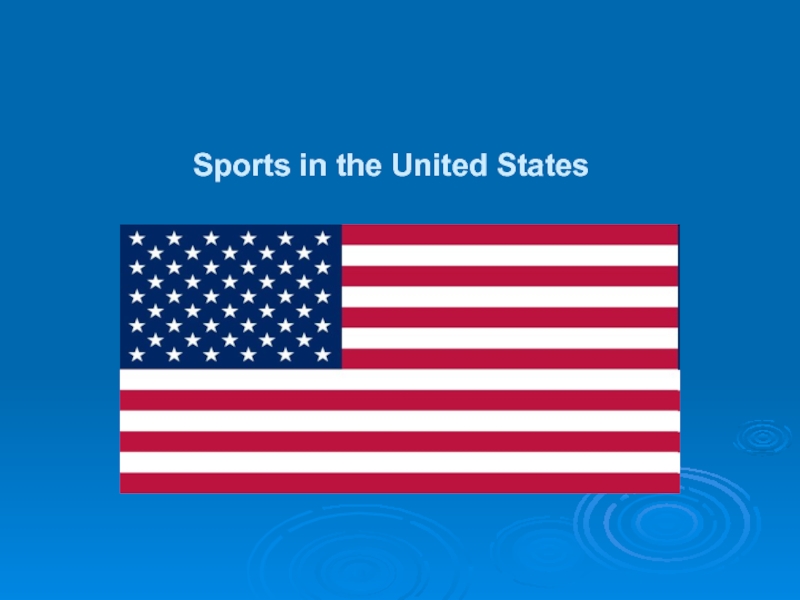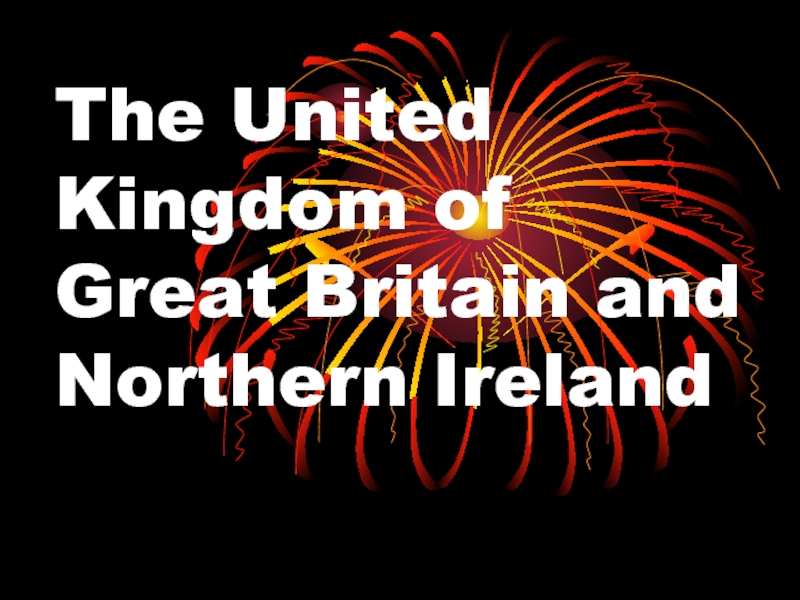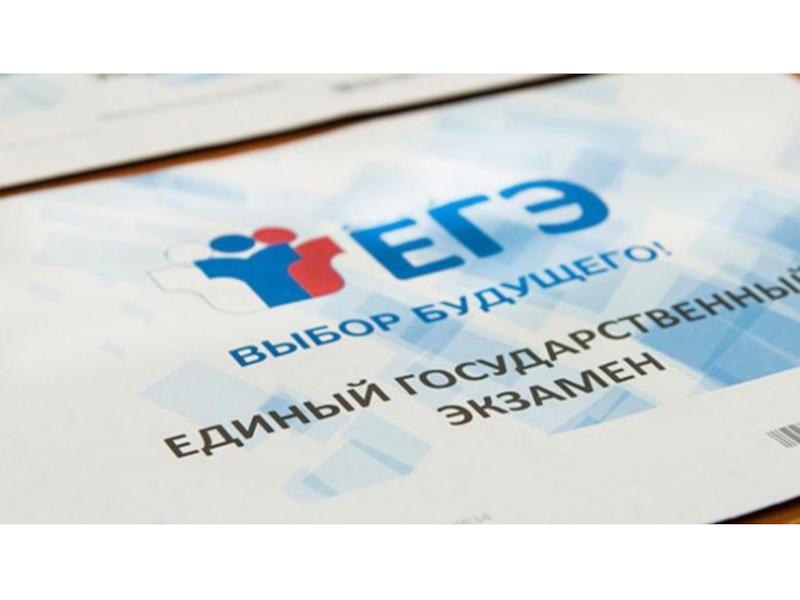- Главная
- Разное
- Дизайн
- Бизнес и предпринимательство
- Аналитика
- Образование
- Развлечения
- Красота и здоровье
- Финансы
- Государство
- Путешествия
- Спорт
- Недвижимость
- Армия
- Графика
- Культурология
- Еда и кулинария
- Лингвистика
- Английский язык
- Астрономия
- Алгебра
- Биология
- География
- Детские презентации
- Информатика
- История
- Литература
- Маркетинг
- Математика
- Медицина
- Менеджмент
- Музыка
- МХК
- Немецкий язык
- ОБЖ
- Обществознание
- Окружающий мир
- Педагогика
- Русский язык
- Технология
- Физика
- Философия
- Химия
- Шаблоны, картинки для презентаций
- Экология
- Экономика
- Юриспруденция
Spotlight on English-speaking countries презентация
Содержание
- 1. Spotlight on English-speaking countries
- 2. ENGLISH-SPEAKING COUNTRIES The UK government classifies
- 3. THE UNITED KINGDOM OF GREAT BRITAIN AND
- 4. THE UNITED KINGDOM OF GREAT BRITAIN AND NORTHERN IRELAND
- 5. THE UK WAS CREATED IN 1707. HOWEVER,
- 6. THE UNITED KINGDOM OF GB AND NI
- 7. LONDON The Romans founded London on the
- 8. EDINBURGH Edinburgh began as a fort.
- 9. BELFAST The history of Belfast as a settlement goes
- 10. CARDIFF Cardiff began as a Roman fort
- 11. NAMES OF MEMBERS England – ‘Engla land’,
- 12. ENGLISH-SPEAKING COUNTRIES THE UK – GREAT BRITAIN Coat of Arms Union Jack
- 13. UNION JACK It is made up of
- 14. COAT OF ARMS The coat of arms
- 15. SYMBOLS OF THE UK ENGLAND
- 16. LION It traditionally symbolizes bravery, strength, and
- 17. TUDOR ROSE Once upon a time there
- 18. SYMBOLS OF THE UK SCOTLAND
- 19. THISTLE Legend has it that at some
- 20. THE KILT For anyone of Scottish ancestry, the kilt
- 21. SYMBOLS OF THE UK WALES
- 22. THE DAFFODILS AND THE LEEK Why the
- 23. SYMBOLS OF THE UK NORTHERN IRELAND
- 24. SHAMROCK Why a shamrock? It was the
- 25. HARP Why a harp? While its earliest
- 26. PATRON SAINTS
- 27. SAINT GEORGE The Patron Saint of England
- 28. SAINT ANDREW The Patron Saint of Scotland
- 29. PATRON SAINTS
- 30. SAINT DAVID The Patron Saint of Wales
- 31. ST PATRICK The Patron Saint of Northern
- 32. BRITISH NATIONAL ANTHEM God save our gracious
- 33. BRITANNIA There is a national personification of
- 34. BRITANNIA The symbol of Britannia has been
- 35. RULE BRITANNIA! When Britain first, at Heaven's
- 36. THE UNITED STATES OF AMERICA
- 37. THE USA The
- 38. WASHINGTON DC Founded on July 16, 1790,
- 39. STARS AND STRIPES It consists of 13
- 40. THE GREAT SEAL OF THE UNITED STATES
- 41. SYMBOLS OF THE USA
- 42. THE BALD EAGLE The bald eagle was
- 43. UNCLE SAM The most cited origin story
- 44. THE STAR SPANGLED BANNER Oh, say! can
- 45. SIMILAR SYMBOLS OF THE UK AND THE
- 46. AMERICAN BEAUTY ROSE In 1875 it was
- 47. SIMILAR SYMBOLS OF THE UK AND THE
- 48. CANADA
- 49. ENGLISH-SPEAKING COUNTRIES CANADA
- 50. OTTAWA Ottawa is the capital of
- 51. COAT OF ARMS The word Canada is
- 52. CANADIAN SYMBOLS
- 53. MAPLE LEAF One of the most recognizable
- 54. THE MAPLE LEAF TARTAN The Maple Leaf
- 55. CANADIAN NATIONAL ANTHEM
- 56. AUSTRALIA
- 57. ENGLISH-SPEAKING COUNTRIES AUSTRALIA
- 58. CANBERRA European settlement in the area
- 59. COAT OF ARMS The coat of arms
- 60. AUSTRALIAN FLAG The flag shows us a
- 61. AUSTRALIAN SYMBOLS
- 62. KANGAROO Australia has been long associated with
- 63. A GOLDEN WATTLE It is a
- 64. AUSTRALIAN NATIONAL ANTHEM
- 65. NEW ZEALAND
- 66. ENGLISH-SPEAKING COUNTRIES NEW ZEALAND
- 67. WELLINGTON In 1865 Wellington became the capital
- 68. NEW ZEALAND The flag shows us a
- 69. NEW ZEALAND COAT OF ARMS
- 70. NEW ZEALAND. SYMBOLS.
- 71. KIWI Kiwi is a national symbol and
- 72. SILVER FERN Ferns are an unofficial symbol
- 73. NATIONAL ANTHEM OF NEW ZEALAND
- 74. TO BE CONTINUED…
Слайд 2ENGLISH-SPEAKING COUNTRIES
The UK government classifies the following overseas countries as majority
native English speaking:
Antigua and Barbuda Australia The Bahamas Barbados
Belize Canada Dominica
Grenada Guyana Ireland
Jamaica New Zealand
St Kitts and Nevis St Lucia
St Vincent and the Grenadines Trinidad and Tobago
The United Kingdom The United States of America
Antigua and Barbuda Australia The Bahamas Barbados
Belize Canada Dominica
Grenada Guyana Ireland
Jamaica New Zealand
St Kitts and Nevis St Lucia
St Vincent and the Grenadines Trinidad and Tobago
The United Kingdom The United States of America
Слайд 3THE UNITED KINGDOM OF GREAT BRITAIN AND NORTHERN IRELAND, THE UNITED STATES
OF AMERICA, CANADA, AUSTRALIA, NEW ZEALAND
The biggest English-speaking countries
Слайд 5THE UK WAS CREATED IN 1707. HOWEVER, AT THAT TIME IT
INCLUDED ONLY THE KINGDOM OF ENGLAND AND THE KINGDOM OF SCOTLAND.
IN 1801 THE KINGDOMS OF GREAT BRITAIN AND IRELAND MERGED TO FORM THE UK OF GB AND IRELAND.
AND IN 1922 A PART OF IRELAND DECIDED TO BE INDEPENDENT. THEN THE STATE WAS RENAMED THE "UNITED KINGDOM OF GREAT BRITAIN AND NORTHERN IRELAND" – ITS FORMAL NAME AT PRESENT.
AS FOR WALES, IT BECAME A PART OF ENGLISH KINGDOM IN THE 16TH CENTURY AND UNDER ENGLAND'S AUTHORITY, WALES BECAME PART OF THE KINGDOM OF GREAT BRITAIN IN 1707 AND THEN IN 1801 THE UK.
Formation of the UK
Слайд 7LONDON
The Romans founded London on the River Thames in 43 AD.
Its name is derived from the Celtic word Londinios, which means the place of the bold one.
London (then called Londinium) had also been the capital of Roman Brittania, but during the early days the Roman administration was in Colchester (Camulodinum)
London did not become the capital city of England until the 12th century.
Winchester was the capital of England before London.
London (then called Londinium) had also been the capital of Roman Brittania, but during the early days the Roman administration was in Colchester (Camulodinum)
London did not become the capital city of England until the 12th century.
Winchester was the capital of England before London.
Слайд 8EDINBURGH
Edinburgh began as a fort.
Its origins as a settlement can be
traced to the early Middle Ages.
In the 7th century the English captured this part of Scotland and they called this place Eiden's burgh (burgh is an old word for fort).
By the middle of the 14th century was being described as the capital of Scotland.
In the 7th century the English captured this part of Scotland and they called this place Eiden's burgh (burgh is an old word for fort).
By the middle of the 14th century was being described as the capital of Scotland.
Слайд 9BELFAST
The history of Belfast as a settlement goes back to the Bronze Age.
The
name comes from Irish Béal Feirste, meaning ’’mouth of the sandbacks’’
Belfast was made the capital of Northern Ireland in 1920.
Belfast was made the capital of Northern Ireland in 1920.
Слайд 10CARDIFF
Cardiff began as a Roman fort (in about 55 AD they
built a fort on the site of Cardiff).
Cardiff was proclaimed the capital of Wales only in 1955 (Wales did not have an official capital before that).
Caerdyf (Welsh word) has its origins in the words meaning “the fort of the Taff”
The River Taff is a large river in Wales.
Cardiff was proclaimed the capital of Wales only in 1955 (Wales did not have an official capital before that).
Caerdyf (Welsh word) has its origins in the words meaning “the fort of the Taff”
The River Taff is a large river in Wales.
Слайд 11NAMES OF MEMBERS
England – ‘Engla land’, meaning the land of the
Angles – a Germanic people who settled in Britain.
Scotland – ‘Scoti’ – dark because of the mist.
Wales – Volcae – walha, variably spelled as walask, walahisk, walhisk etc. 'strange, foreign, Romance.'
Ireland – Éire – Ériu – a Gaelic goddess –
the matron goddess of Ireland, a goddess of sovereignty, a goddess of the land
Great Britain – Britannia – inhabited by the Britons – an ancient Celtic people.
Scotland – ‘Scoti’ – dark because of the mist.
Wales – Volcae – walha, variably spelled as walask, walahisk, walhisk etc. 'strange, foreign, Romance.'
Ireland – Éire – Ériu – a Gaelic goddess –
the matron goddess of Ireland, a goddess of sovereignty, a goddess of the land
Great Britain – Britannia – inhabited by the Britons – an ancient Celtic people.
Слайд 13UNION JACK
It is made up of three crosses. The upright red
cross is the cross of St. George, the patron saint of England. The white diagonal cross is the cross of St. Andrew, the patron saint of Scotland. The red diagonal cross is the cross of saint Patrick, the patron saint of Ireland.
Слайд 14COAT OF ARMS
The coat of arms represents a quartered shield. In
the first and fourth quarters you can see lions which symbolize England, in the second there is a rampant lion and a fleur-de-lis [flɜ:də'li:] which symbolize Scotland and in the third there is a harp for Ireland.
The shield is being taken by a guardant lion (a symbol of England) wearing St. Edward’s crown and a unicorn which symbolizes Scotland.
Under the shield you can also see a flowerbed with Tudor roses (England), a thistle (Scotland) and a shamrock (Ireland).
The shield is being taken by a guardant lion (a symbol of England) wearing St. Edward’s crown and a unicorn which symbolizes Scotland.
Under the shield you can also see a flowerbed with Tudor roses (England), a thistle (Scotland) and a shamrock (Ireland).
Слайд 16LION
It traditionally symbolizes bravery, strength, and royalty, because historically it has
been regarded as the king of beasts.
The lion seems to have shown up on individual English royals' coats of arms back in the 12th century, and it was certainly used by continental royals and semi-royals before William the Conqueror got himself across the Channel. Later, it was simply incorporated into English royal coats of arms, which were in turn incorporated into British/United Kingdom arms.
The lion seems to have shown up on individual English royals' coats of arms back in the 12th century, and it was certainly used by continental royals and semi-royals before William the Conqueror got himself across the Channel. Later, it was simply incorporated into English royal coats of arms, which were in turn incorporated into British/United Kingdom arms.
Слайд 17TUDOR ROSE
Once upon a time there were two dukes in Britain.
The symbol of the first one was a red rose of the second one was a white rose. They were at war for the throne of England. The winner was the duke whose symbol was a red rose. So, when he became the king he made this flower the symbol of the country. This war is known as the Wars of the Roses in 1455-1485.
Слайд 19THISTLE
Legend has it that at some point during the invasion the
Norsemen tried to surprise the sleeping Scottish warriors. In order to move more quiet at night the Norsemen removed their shoes. But as they were barefoot they came across an area of ground covered in thistles and one of them unfortunately stood on a thistle and screamed in pain. The Scottish woke up and the important role that the thistle had played was recognized and so it was chosen as Scotland's national emblem.
Слайд 20THE KILT
For anyone of Scottish ancestry, the kilt is a symbol of honor for
the clan which they belong. The kilt is more than just a covering. In the past it allowed those who wore it to move much more freely, especially in the Highlands of Scotland.
Bagpipe: The bagpipe is the national instrument of Scotland.
Bagpipe: The bagpipe is the national instrument of Scotland.
Слайд 22THE DAFFODILS AND THE LEEK
Why the leek? The legend says that
St David advised the Britons on the eve of a battle with the Saxons, to wear leeks in their caps so that they could easily distinguish friend from foe. This apparently helped to secure a great victory.
Why daffodils? Possibly the reason why the daffodil is used as an emblem is that the word for daffodil and for leek are the same in Welsh (Cenhinen = Leek, Cenhinen Pedr = Daffodil). This confusion means that both have been adopted as national emblems.
Why daffodils? Possibly the reason why the daffodil is used as an emblem is that the word for daffodil and for leek are the same in Welsh (Cenhinen = Leek, Cenhinen Pedr = Daffodil). This confusion means that both have been adopted as national emblems.
Слайд 24SHAMROCK
Why a shamrock? It was the Celtic druids who started the
shamrock on its path to Irish glory! They believed the no. 3 to be a perfect number and, as such, to have mystical powers. Then St Patrick according to legend used the plant to illustrate the Christian concept of the Trinity i.e. to show how one God divided into three: God the Father, God the Son, and God the Holy Spirit.
Слайд 25HARP
Why a harp? While its earliest origins are lost, the Irish
harp has a certain history dating back at least 1000 years. Brian Boru, the last High King of Ireland (1014), is said to have been an accomplished player. It was de rigeur for Scottish and Irish kings and chieftains to have their own resident harper who, in turn, enjoyed high status and special privileges.
Слайд 27SAINT GEORGE
The Patron Saint of England is Saint George.
It seems
that the Emperor Diocletian had St. George tortured to make him deny his faith in Christ. However despite some of the most terrible torture even for that time, St George showed incredible courage and faith and was finally beheaded in Palestine.
The best-known story about St. George is his fight with a dragon. In the Middle Ages the dragon was commonly used to represent the Devil.
According to one of the legends. St. George killed a dragon on the flat topped Dragon Hill in Uffington, Berkshire, and it is said that no grass grows where the dragon’s blood trickled down.
His Day is celebrated annually on 23 April.
The best-known story about St. George is his fight with a dragon. In the Middle Ages the dragon was commonly used to represent the Devil.
According to one of the legends. St. George killed a dragon on the flat topped Dragon Hill in Uffington, Berkshire, and it is said that no grass grows where the dragon’s blood trickled down.
His Day is celebrated annually on 23 April.
Слайд 28SAINT ANDREW
The Patron Saint of Scotland is Saint Andrew. Not much
is known about the life of St Andrew or exactly how he came to be patron saint of Scotland but he was believed to have been a fisherman and one of Jesus’ first Apostles.
He was sentenced to death by crucifixion by the Romans in Greece, but he requested to be crucified on a diagonal cross as he felt he was not worthy enough to die on the same shape of cross as Jesus.
St Andrew's Day falls on 30 November in Scotland.
He was sentenced to death by crucifixion by the Romans in Greece, but he requested to be crucified on a diagonal cross as he felt he was not worthy enough to die on the same shape of cross as Jesus.
St Andrew's Day falls on 30 November in Scotland.
Слайд 30SAINT DAVID
The Patron Saint of Wales is Saint David. March 1st
is St. David’s Day.
In medieval times it was believed that St David was the nephew of King Arthur.
According to legend David performed several miracles during his life including restoring Paulinus' sight.
It is also said that during a battle against the Saxons, David advised his soldiers to wear leeks in their hats so that they could easily be distinguished from their enemies, which is why the leek is one of the national emblems of Wales.
In medieval times it was believed that St David was the nephew of King Arthur.
According to legend David performed several miracles during his life including restoring Paulinus' sight.
It is also said that during a battle against the Saxons, David advised his soldiers to wear leeks in their hats so that they could easily be distinguished from their enemies, which is why the leek is one of the national emblems of Wales.
Слайд 31ST PATRICK
The Patron Saint of Northern Ireland is St. Patrick. There
is a cultural and religious celebration held on 17 March.
Saint Patrick is given credit for banishing the snakes from Ireland, sending the broods into the sea. To this day, there aren't any native snakes in Ireland. The banishment of snakes is probably an allegorical explanation for Patrick confronting and defeating paganism. As depicted in medieval art, pagans often worshipped snakes. The absence of snakes is more likely to be caused by the remoteness of the island. Fortunately, Ireland was inaccessible for snakes to reach.
Saint Patrick is given credit for banishing the snakes from Ireland, sending the broods into the sea. To this day, there aren't any native snakes in Ireland. The banishment of snakes is probably an allegorical explanation for Patrick confronting and defeating paganism. As depicted in medieval art, pagans often worshipped snakes. The absence of snakes is more likely to be caused by the remoteness of the island. Fortunately, Ireland was inaccessible for snakes to reach.
Слайд 32BRITISH NATIONAL ANTHEM
God save our gracious Queen!
Long live our noble Queen!
God
save the Queen!
Send her victorious,
Happy and glorious,
Long to reign over us,
God save the Queen.
Thy choicest gifts in store On her be pleased to pour, Long may she reign. May she defend our laws, And ever give us cause, To sing with heart and voice, God save the Queen.
https://www.youtube.com/watch?v=tN9EC3Gy6Nk
Thy choicest gifts in store On her be pleased to pour, Long may she reign. May she defend our laws, And ever give us cause, To sing with heart and voice, God save the Queen.
https://www.youtube.com/watch?v=tN9EC3Gy6Nk
Слайд 33BRITANNIA
There is a national personification of the UK. The personification is
called Britannia.
Britannia is simbolized as a young woman with brown or golden hair , wearing a helmet and a white robe. She holds a trident and a shield bearing a union flag. The symbol appeared in the 17th century after James I brought together England, Scotland , Wales and Ireland under one rule.
Britannia is simbolized as a young woman with brown or golden hair , wearing a helmet and a white robe. She holds a trident and a shield bearing a union flag. The symbol appeared in the 17th century after James I brought together England, Scotland , Wales and Ireland under one rule.
Слайд 34BRITANNIA
The symbol of Britannia has been used for thousands of years,
but who was this mythical female warrior, seated on a shield in her Corinthian helmet, holding a trident with the British lion at her side? Britannia was, in fact, the original Latin name given to Great Britain, when it was first occupied by the Romans in AD 43. The Romans made her a goddess and her originally bare-breasted figure, holding a spear, first appeared on a Roman coin 100 years later, during the reign of Antoninus Pius. With the creation of the United Kingdom in 1707, Britannia became the figurehead of British imperial and military power. Now bearing the Union Flag on her shield, she became a more prominent national emblem, linked to the Navy, at a time when Britannia did indeed “rule the waves”.
Слайд 35RULE BRITANNIA!
When Britain first, at Heaven's command
Arose from out the azure
main;
This was the charter of the land,
And guardian angels sang this strain:
"Rule, Britannia! rule the waves:"Britons never will be slaves.“
https://www.youtube.com/watch?v=yHNfvJc99YY
This was the charter of the land,
And guardian angels sang this strain:
"Rule, Britannia! rule the waves:"Britons never will be slaves.“
https://www.youtube.com/watch?v=yHNfvJc99YY
Слайд 37
THE USA
The USA is a federal republic consisting of 50 states
and a federal district (Washington DC) . Capital city is Washington.
Слайд 38WASHINGTON DC
Founded on July 16, 1790, Washington DC was established by
the Constitution of the United States to serve as the nation’s capital.
George Washington, the first president and namesake of the city, chose the site.
DC = District of Columbia
From "Columbia," a name commonly applied to the Unite States in the late 18th century derived from Christopher Columbus who discovered America in 1492.
George Washington, the first president and namesake of the city, chose the site.
DC = District of Columbia
From "Columbia," a name commonly applied to the Unite States in the late 18th century derived from Christopher Columbus who discovered America in 1492.
Слайд 39STARS AND STRIPES
It consists of 13 equal horizontal stripes of red
(top and bottom) alternating with white , with a blue rectangle.
The 50 stars represent the 50 states of the USA. And the 13 stripes represent the 13 British colonies which declared independence from Britain and became the first states in the Union.
The 50 stars represent the 50 states of the USA. And the 13 stripes represent the 13 British colonies which declared independence from Britain and became the first states in the Union.
Слайд 40THE GREAT SEAL OF THE UNITED STATES
In the centre there is
a shield almost similar to the American flag. However, there are no stars and the stripes are white (not red).
The supporter of the shield is a bald eagle. It holds 13 arrows (symbolizing 13 states) and an olive branch (a symbol of peace) with 13 leaves and 13 olives.
In the eagle’s beak you can see a scroll with the motto Et pluribus unum (Out of many, One).
There is also a motto which says In God We Trust.
The supporter of the shield is a bald eagle. It holds 13 arrows (symbolizing 13 states) and an olive branch (a symbol of peace) with 13 leaves and 13 olives.
In the eagle’s beak you can see a scroll with the motto Et pluribus unum (Out of many, One).
There is also a motto which says In God We Trust.
Слайд 42THE BALD EAGLE
The bald eagle was chosen June 20, 1782 as
the emblem of the United States of America, because of its long life, great strength and majestic looks, and also because it was then believed to exist only on this continent.
It is said the eagle was used as a national emblem because, at one of the first battles of the Revolution (which occurred early in the morning) the noise of the struggle awoke the sleeping eagles on the heights and they flew from their nests and circled about over the heads of the fighting men, all the while giving vent to their raucous cries. "They are shrieking for Freedom," said the patriots.
It is said the eagle was used as a national emblem because, at one of the first battles of the Revolution (which occurred early in the morning) the noise of the struggle awoke the sleeping eagles on the heights and they flew from their nests and circled about over the heads of the fighting men, all the while giving vent to their raucous cries. "They are shrieking for Freedom," said the patriots.
Слайд 43UNCLE SAM
The most cited origin story traces Uncle Sam back to
a man in Troy, New York.
Sam Wilson delivered meat packed in barrels to soldiers during the War of 1812. Wilson was a well-liked man, and local residents called him "Uncle Sam."
When people around town saw those supply barrels marked "U.S." they assumed the letters meant Uncle Sam, and the soldiers adopted the same thinking. In reality, Wilson had labeled the barrels "U.S." for "United States," and so the two ideas merged—Uncle Sam became a symbol for the United States of America.
Sam Wilson delivered meat packed in barrels to soldiers during the War of 1812. Wilson was a well-liked man, and local residents called him "Uncle Sam."
When people around town saw those supply barrels marked "U.S." they assumed the letters meant Uncle Sam, and the soldiers adopted the same thinking. In reality, Wilson had labeled the barrels "U.S." for "United States," and so the two ideas merged—Uncle Sam became a symbol for the United States of America.
Слайд 44THE STAR SPANGLED BANNER
Oh, say! can you see by the dawn's
early light
What so proudly we hailed at the twilight's last gleaming;
Whose broad stripes and bright stars, through the perilous fight,
O'er the ramparts we watched were so gallantly streaming?
And the rocket's red glare, the bombs bursting in air,
Gave proof through the night that our flag was still there:
Oh, say! does that star-spangled banner yet wave
O'er the land of the free and the home of the brave?
https://www.youtube.com/watch?v=M1wLtAXDgqg
https://www.youtube.com/watch?v=M1wLtAXDgqg
Слайд 45SIMILAR SYMBOLS OF THE UK AND THE USA
American Beauty Rose (an
official flower of the District of Columbia)
Tudor Rose (English symbol)
Слайд 46AMERICAN BEAUTY ROSE
In 1875 it was brought to the USA.
It was
introduced as a new rose cultivar named 'American Beauty‘.
Due to its high price per stem (at least two dollars per stem) and its popularity, the cultivar was called the million-dollar-rose.
Due to its high price per stem (at least two dollars per stem) and its popularity, the cultivar was called the million-dollar-rose.
Слайд 47SIMILAR SYMBOLS OF THE UK AND THE USA
The national tree of
England –
the oak-tree
the oak-tree
Scarlet oak (an official tree of Washington DC)
Слайд 50OTTAWA
Ottawa is the capital of Canada.
The origin of the name "Ottawa"
is derived from the Algonquin word adawe, meaning "to trade".
The small logging town was chosen as the country's new capital on December 31st, 1857
Queen Victoria herself was asked to choose a capital for the province of Canada, which at that time consisted of the two colonies of Quebec and Ontario, and there’s a story that she simply stuck a hatpin into a map, between Toronto and Montreal.
Another story has her choosing Ottawa because she had liked landscape paintings of the area
The small logging town was chosen as the country's new capital on December 31st, 1857
Queen Victoria herself was asked to choose a capital for the province of Canada, which at that time consisted of the two colonies of Quebec and Ontario, and there’s a story that she simply stuck a hatpin into a map, between Toronto and Montreal.
Another story has her choosing Ottawa because she had liked landscape paintings of the area
Слайд 51COAT OF ARMS
The word Canada is believed to come from the
word Kanata which means “village” or “settlement”.
The coat of arms as you can see is quite similar to the British one. However, some Canadian symbols have been added. For instance, the famous maple leaf which you can also see in the flag.
You can also see a motto which says A Mari usque ad Mare which means From sea to sea.
The coat of arms as you can see is quite similar to the British one. However, some Canadian symbols have been added. For instance, the famous maple leaf which you can also see in the flag.
You can also see a motto which says A Mari usque ad Mare which means From sea to sea.
Слайд 53MAPLE LEAF
One of the most recognizable Canadian symbols is a maple
leaf (or a maple tree). Why? Well before the coming of the first European settlers, Canada's aboriginal peoples had discovered the food properties of maple sap, which they gathered every spring. According to many historians, the maple leaf began to serve as a Canadian symbol as early as 1700.
Слайд 54THE MAPLE LEAF TARTAN
The Maple Leaf Tartan was created in 1964
by David Weiser in anticipation of the 100th anniversary of Canada's confederation in 1967. It was designed to be worn by Canadians as a symbol of national pride.
The colors of the maple leaf through the changing seasons became the basis for the design.
The pattern incorporates the green of the leaves' summer foliage, the gold which first appears in the early autumn, the red which appears with the coming of the first frost, and the brown tones of the fallen leaves. The design proved to be very popular throughout Canada.
The colors of the maple leaf through the changing seasons became the basis for the design.
The pattern incorporates the green of the leaves' summer foliage, the gold which first appears in the early autumn, the red which appears with the coming of the first frost, and the brown tones of the fallen leaves. The design proved to be very popular throughout Canada.
Слайд 58CANBERRA
European settlement in the area can be said to have begun
in 1824.
There are three alternative theories for the derivation of the word 'Canberra'. First, that it came from the name of the property 'Camberry Station' on which the center of Canberra was later built.
Second, it was named after the profusion of Cranberries growing in the area.
Third, the word Canberra is derived from the renditions into written English of the name of the location Ngambri.
The Australian Capital Territory was declared on 1 January 1911.
There are three alternative theories for the derivation of the word 'Canberra'. First, that it came from the name of the property 'Camberry Station' on which the center of Canberra was later built.
Second, it was named after the profusion of Cranberries growing in the area.
Third, the word Canberra is derived from the renditions into written English of the name of the location Ngambri.
The Australian Capital Territory was declared on 1 January 1911.
Слайд 59COAT OF ARMS
The coat of arms shows the main symbols of
the country such as a kangaroo and an emu ['i:mju:].
The shield in the centre shows us the coats of arms of different parts of Australia such as New South Wales (The Red Cross), Victoria, Queensland, South Australia, Western Australia and Tasmania.
The motto is Advance Australia.
The shield in the centre shows us the coats of arms of different parts of Australia such as New South Wales (The Red Cross), Victoria, Queensland, South Australia, Western Australia and Tasmania.
The motto is Advance Australia.
Слайд 60AUSTRALIAN FLAG
The flag shows us a blue field with a Union
Jack, a large white seven-pointed star which symbolizes the Commonwealth and 5 smaller white stars which represent the Southern Cross constellation.
The Southern Cross is the best known and most represented star group in the Southern Hemisphere.
It can be seen all year round from almost anywhere in Australia.
The Southern Cross is the best known and most represented star group in the Southern Hemisphere.
It can be seen all year round from almost anywhere in Australia.
Слайд 62KANGAROO
Australia has been long associated with kangaroos. However, kangaroos are only
unofficial national mammal emblems.
Слайд 63A GOLDEN WATTLE
It is a tree which flowers in late winter
and spring.
When in flower, the golden wattle displays the national colors green and gold.
Gold means images of Australia’s beaches, mineral wealth, grain harvests and the Australian wool.
Green evokes the forests, eucalyptus trees and the Australian landscape.
The golden wattle is a symbol of unity.
In recent times, the golden wattle has been used as a symbol of remembrance and reflection.
When in flower, the golden wattle displays the national colors green and gold.
Gold means images of Australia’s beaches, mineral wealth, grain harvests and the Australian wool.
Green evokes the forests, eucalyptus trees and the Australian landscape.
The golden wattle is a symbol of unity.
In recent times, the golden wattle has been used as a symbol of remembrance and reflection.
Слайд 67WELLINGTON
In 1865 Wellington became the capital city in place of Auckland.
Wellington
takes its name from Arthur Wellesley , the first duke of Wellington in the English county of Somerset.
It was named by the original settlers of the New Zealand Company in recognition of the Duke's strong support for the company's principles of colonization .
The New Zealand Company was a 19th century English company that played a key role in the colonization o f New Zealand.
It was named by the original settlers of the New Zealand Company in recognition of the Duke's strong support for the company's principles of colonization .
The New Zealand Company was a 19th century English company that played a key role in the colonization o f New Zealand.
Слайд 68NEW ZEALAND
The flag shows us a version of the Union Jack
combined with the constellation of Crux in the Southern Red Cross.
Beginning in the colonial age, Crux became used as a national symbol by several southern nations. The brightest stars of Crux appear on the flags of New Zealand, Australia, Brazil, Papua new Guinea and Samoa.
It plays an important role in navigation.
Beginning in the colonial age, Crux became used as a national symbol by several southern nations. The brightest stars of Crux appear on the flags of New Zealand, Australia, Brazil, Papua new Guinea and Samoa.
It plays an important role in navigation.
Слайд 69NEW ZEALAND
COAT OF ARMS
The first quarter of the shield
shows four stars that represent the Southern Cross, then three ships symbolizing the importance of New Zealand's sea trade. In the second quarter a fleece represents the farming industry. The wheat sheaf in the third quarter represents the agricultural industry, and the crossed hammers in the fourth quarter represent mining.
The supporters on either side of the shield are a Māori Chieftain holding a taiaha (a Māori war weapon) and a European woman holding the New Zealand Ensign. St Edward's Crown, shown above the shield, was used in the Coronation ceremony of Her Majesty Queen Elizabeth II.
The supporters on either side of the shield are a Māori Chieftain holding a taiaha (a Māori war weapon) and a European woman holding the New Zealand Ensign. St Edward's Crown, shown above the shield, was used in the Coronation ceremony of Her Majesty Queen Elizabeth II.
Слайд 71KIWI
Kiwi is a national symbol and icon of New Zealand.
The
name of the bird – Kiwi comes from the language of Maori (indigenous NZ people). It means “hidden bird”.
It is now believed that only 200 birds are left in the wild.
The association between Kiwis and NZ is so strong that often the word Kiwi is used to refer to the people of New Zealand. Kiwi appeared as a symbol for the first time in the middle of the 19 century when it is pictured on New Zealand regimental badges.
It is now believed that only 200 birds are left in the wild.
The association between Kiwis and NZ is so strong that often the word Kiwi is used to refer to the people of New Zealand. Kiwi appeared as a symbol for the first time in the middle of the 19 century when it is pictured on New Zealand regimental badges.
Слайд 72SILVER FERN
Ferns are an unofficial symbol of New Zealand’s national identity.
Their dominance in native bush, and their importance as food and medicine, led to their common use as design elements in traditional Māori carving.
Today, the koru is used as a commercial logo for Air New Zealand.
Today’s New Zealand Post uses the silver fern for marketing its stamps, and it has also appeared on coins, banknotes and the nation’s coat of arms.
Today, the koru is used as a commercial logo for Air New Zealand.
Today’s New Zealand Post uses the silver fern for marketing its stamps, and it has also appeared on coins, banknotes and the nation’s coat of arms.
